WORD STRUCTURE IN MODERN ENGLISH
I. The morphological structure of a word. Morphemes. Types of morphemes. Allomorphs.
II. Structural types of words.
III. Principles of morphemic analysis.
IV. Derivational level of analysis. Stems. Types of stems. Derivational types of words.
I. The morphological structure of a word. Morphemes. Types of Morphemes. Allomorphs.
There are two levels of approach to the study of word- structure: the level of morphemic analysis and the level of derivational or word-formation analysis.
Word is the principal and basic unit of the language system, the largest on the morphologic and the smallest on the syntactic plane of linguistic analysis.
It has been universally acknowledged that a great many words have a composite nature and are made up of morphemes, the basic units on the morphemic level, which are defined as the smallest indivisible two-facet language units.
The term morpheme is derived from Greek morphe “form ”+ -eme. The Greek suffix –eme has been adopted by linguistic to denote the smallest unit or the minimum distinctive feature.
The morpheme is the smallest meaningful unit of form. A form in these cases a recurring discrete unit of speech. Morphemes occur in speech only as constituent parts of words, not independently, although a word may consist of single morpheme. Even a cursory examination of the morphemic structure of English words reveals that they are composed of morphemes of different types: root-morphemes and affixational morphemes. Words that consist of a root and an affix are called derived words or derivatives and are produced by the process of word building known as affixation (or derivation).
The root-morpheme is the lexical nucleus of the word; it has a very general and abstract lexical meaning common to a set of semantically related words constituting one word-cluster, e.g. (to) teach, teacher, teaching. Besides the lexical meaning root-morphemes possess all other types of meaning proper to morphemes except the part-of-speech meaning which is not found in roots.
Affixational morphemes include inflectional affixes or inflections and derivational affixes. Inflections carry only grammatical meaning and are thus relevant only for the formation of word-forms. Derivational affixes are relevant for building various types of words. They are lexically always dependent on the root which they modify. They possess the same types of meaning as found in roots, but unlike root-morphemes most of them have the part-of-speech meaning which makes them structurally the important part of the word as they condition the lexico-grammatical class the word belongs to. Due to this component of their meaning the derivational affixes are classified into affixes building different parts of speech: nouns, verbs, adjectives or adverbs.
Roots and derivational affixes are generally easily distinguished and the difference between them is clearly felt as, e.g., in the words helpless, handy, blackness, Londoner, refill, etc.: the root-morphemes help-, hand-, black-, London-, fill-, are understood as the lexical centers of the words, and –less, -y, -ness, -er, re- are felt as morphemes dependent on these roots.
Distinction is also made of free and bound morphemes.
Free morphemes coincide with word-forms of independently functioning words. It is obvious that free morphemes can be found only among roots, so the morpheme boy- in the word boy is a free morpheme; in the word undesirable there is only one free morpheme desire-; the word pen-holder has two free morphemes pen- and hold-. It follows that bound morphemes are those that do not coincide with separate word- forms, consequently all derivational morphemes, such as –ness, -able, -er are bound. Root-morphemes may be both free and bound. The morphemes theor- in the words theory, theoretical, or horr- in the words horror, horrible, horrify; Angl- in Anglo-Saxon; Afr- in Afro-Asian are all bound roots as there are no identical word-forms.
It should also be noted that morphemes may have different phonemic shapes. In the word-cluster please , pleasing , pleasure , pleasant the phonemic shapes of the word stand in complementary distribution or in alternation with each other. All the representations of the given morpheme, that manifest alternation are called allomorphs/or morphemic variants/ of that morpheme.
The combining form allo- from Greek allos “other” is used in linguistic terminology to denote elements of a group whose members together consistute a structural unit of the language (allophones, allomorphs). Thus, for example, -ion/ -tion/ -sion/ -ation are the positional variants of the same suffix, they do not differ in meaning or function but show a slight difference in sound form depending on the final phoneme of the preceding stem. They are considered as variants of one and the same morpheme and called its allomorphs.
Allomorph is defined as a positional variant of a morpheme occurring in a specific environment and so characterized by complementary description.
Complementary distribution is said to take place, when two linguistic variants cannot appear in the same environment.
Different morphemes are characterized by contrastive distribution, i.e. if they occur in the same environment they signal different meanings. The suffixes –able and –ed, for instance, are different morphemes, not allomorphs, because adjectives in –able mean “ capable of beings”.
Allomorphs will also occur among prefixes. Their form then depends on the initials of the stem with which they will assimilate.
Two or more sound forms of a stem existing under conditions of complementary distribution may also be regarded as allomorphs, as, for instance, in long a: length n.
II. Structural types of words.
The morphological analysis of word- structure on the morphemic level aims at splitting the word into its constituent morphemes – the basic units at this level of analysis – and at determining their number and types. The four types (root words, derived words, compound, shortenings) represent the main structural types of Modern English words, and conversion, derivation and composition the most productive ways of word building.
According to the number of morphemes words can be classified into monomorphic and polymorphic. Monomorphic or root-words consist of only one root-morpheme, e.g. small, dog, make, give, etc. All polymorphic word fall into two subgroups: derived words and compound words – according to the number of root-morphemes they have. Derived words are composed of one root-morpheme and one or more derivational morphemes, e.g. acceptable, outdo, disagreeable, etc. Compound words are those which contain at least two root-morphemes, the number of derivational morphemes being insignificant. There can be both root- and derivational morphemes in compounds as in pen-holder, light-mindedness, or only root-morphemes as in lamp-shade, eye-ball, etc.
These structural types are not of equal importance. The clue to the correct understanding of their comparative value lies in a careful consideration of: 1)the importance of each type in the existing wordstock, and 2) their frequency value in actual speech. Frequency is by far the most important factor. According to the available word counts made in different parts of speech, we find that derived words numerically constitute the largest class of words in the existing wordstock; derived nouns comprise approximately 67% of the total number, adjectives about 86%, whereas compound nouns make about 15% and adjectives about 4%. Root words come to 18% in nouns, i.e. a trifle more than the number of compound words; adjectives root words come to approximately 12%.
But we cannot fail to perceive that root-words occupy a predominant place. In English, according to the recent frequency counts, about 60% of the total number of nouns and 62% of the total number of adjectives in current use are root-words. Of the total number of adjectives and nouns, derived words comprise about 38% and 37% respectively while compound words comprise an insignificant 2% in nouns and 0.2% in adjectives. Thus it is the root-words that constitute the foundation and the backbone of the vocabulary and that are of paramount importance in speech. It should also be mentioned that root words are characterized by a high degree of collocability and a complex variety of meanings in contrast with words of other structural types whose semantic structures are much poorer. Root- words also serve as parent forms for all types of derived and compound words.
III. Principles of morphemic analysis.
In most cases the morphemic structure of words is transparent enough and individual morphemes clearly stand out within the word. The segmentation of words is generally carried out according to the method of Immediate and Ultimate Constituents. This method is based on the binary principle, i.e. each stage of the procedure involves two components the word immediately breaks into. At each stage these two components are referred to as the Immediate Constituents. Each Immediate Constituent at the next stage of analysis is in turn broken into smaller meaningful elements. The analysis is completed when we arrive at constituents incapable of further division, i.e. morphemes. These are referred to Ultimate Constituents.
A synchronic morphological analysis is most effectively accomplished by the procedure known as the analysis into Immediate Constituents. ICs are the two meaningful parts forming a large linguistic unity.
The method is based on the fact that a word characterized by morphological divisibility is involved in certain structural correlations. To sum up: as we break the word we obtain at any level only ICs one of which is the stem of the given word. All the time the analysis is based on the patterns characteristic of the English vocabulary. As a pattern showing the interdependence of all the constituents segregated at various stages, we obtain the following formula:
un+ { [ ( gent- + -le ) + -man ] + -ly}
Breaking a word into its Immediate Constituents we observe in each cut the structural order of the constituents.
A diagram presenting the four cuts described looks as follows:
1. un- / gentlemanly
2. un- / gentleman / — ly
3. un- / gentle / — man / — ly
4. un- / gentl / — e / — man / — ly
A similar analysis on the word-formation level showing not only the morphemic constituents of the word but also the structural pattern on which it is built.
The analysis of word-structure at the morphemic level must proceed to the stage of Ultimate Constituents. For example, the noun friendliness is first segmented into the ICs: [frendlı-] recurring in the adjectives friendly-looking and friendly and [-nıs] found in a countless number of nouns, such as unhappiness, blackness, sameness, etc. the IC [-nıs] is at the same time an UC of the word, as it cannot be broken into any smaller elements possessing both sound-form and meaning. Any further division of –ness would give individual speech-sounds which denote nothing by themselves. The IC [frendlı-] is next broken into the ICs [-lı] and [frend-] which are both UCs of the word.
Morphemic analysis under the method of Ultimate Constituents may be carried out on the basis of two principles: the so-called root-principle and affix principle.
According to the affix principle the splitting of the word into its constituent morphemes is based on the identification of the affix within a set of words, e.g. the identification of the suffix –er leads to the segmentation of words singer, teacher, swimmer into the derivational morpheme – er and the roots teach- , sing-, drive-.
According to the root-principle, the segmentation of the word is based on the identification of the root-morpheme in a word-cluster, for example the identification of the root-morpheme agree- in the words agreeable, agreement, disagree.
As a rule, the application of these principles is sufficient for the morphemic segmentation of words.
However, the morphemic structure of words in a number of cases defies such analysis, as it is not always so transparent and simple as in the cases mentioned above. Sometimes not only the segmentation of words into morphemes, but the recognition of certain sound-clusters as morphemes become doubtful which naturally affects the classification of words. In words like retain, detain, contain or receive, deceive, conceive, perceive the sound-clusters [rı-], [dı-] seem to be singled quite easily, on the other hand, they undoubtedly have nothing in common with the phonetically identical prefixes re-, de- as found in words re-write, re-organize, de-organize, de-code. Moreover, neither the sound-cluster [rı-] or [dı-], nor the [-teın] or [-sı:v] possess any lexical or functional meaning of their own. Yet, these sound-clusters are felt as having a certain meaning because [rı-] distinguishes retain from detain and [-teın] distinguishes retain from receive.
It follows that all these sound-clusters have a differential and a certain distributional meaning as their order arrangement point to the affixal status of re-, de-, con-, per- and makes one understand —tain and –ceive as roots. The differential and distributional meanings seem to give sufficient ground to recognize these sound-clusters as morphemes, but as they lack lexical meaning of their own, they are set apart from all other types of morphemes and are known in linguistic literature as pseudo- morphemes. Pseudo- morphemes of the same kind are also encountered in words like rusty-fusty.
IV. Derivational level of analysis. Stems. Types of Stems. Derivational types of word.
The morphemic analysis of words only defines the constituent morphemes, determining their types and their meaning but does not reveal the hierarchy of the morphemes comprising the word. Words are no mere sum totals of morpheme, the latter reveal a definite, sometimes very complex interrelation. Morphemes are arranged according to certain rules, the arrangement differing in various types of words and particular groups within the same types. The pattern of morpheme arrangement underlies the classification of words into different types and enables one to understand how new words appear in the language. These relations within the word and the interrelations between different types and classes of words are known as derivative or word- formation relations.
The analysis of derivative relations aims at establishing a correlation between different types and the structural patterns words are built on. The basic unit at the derivational level is the stem.
The stem is defined as that part of the word which remains unchanged throughout its paradigm, thus the stem which appears in the paradigm (to) ask ( ), asks, asked, asking is ask-; thestem of the word singer ( ), singer’s, singers, singers’ is singer-. It is the stem of the word that takes the inflections which shape the word grammatically as one or another part of speech.
The structure of stems should be described in terms of IC’s analysis, which at this level aims at establishing the patterns of typical derivative relations within the stem and the derivative correlation between stems of different types.
There are three types of stems: simple, derived and compound.
Simple stems are semantically non-motivated and do not constitute a pattern on analogy with which new stems may be modeled. Simple stems are generally monomorphic and phonetically identical with the root morpheme. The derivational structure of stems does not always coincide with the result of morphemic analysis. Comparison proves that not all morphemes relevant at the morphemic level are relevant at the derivational level of analysis. It follows that bound morphemes and all types of pseudo- morphemes are irrelevant to the derivational structure of stems as they do not meet requirements of double opposition and derivative interrelations. So the stem of such words as retain, receive, horrible, pocket, motion, etc. should be regarded as simple, non- motivated stems.
Derived stems are built on stems of various structures though which they are motivated, i.e. derived stems are understood on the basis of the derivative relations between their IC’s and the correlated stems. The derived stems are mostly polymorphic in which case the segmentation results only in one IC that is itself a stem, the other IC being necessarily a derivational affix.
Derived stems are not necessarily polymorphic.
Compound stems are made up of two IC’s, both of which are themselves stems, for example match-box, driving-suit, pen-holder, etc. It is built by joining of two stems, one of which is simple, the other derived.
In more complex cases the result of the analysis at the two levels sometimes seems even to contracted one another.
The derivational types of words are classified according to the structure of their stems into simple, derived and compound words.
Derived words are those composed of one root- morpheme and one or more derivational morpheme.
Compound words contain at least two root- morphemes, the number of derivational morphemes being insignificant.
Derivational compound is a word formed by a simultaneous process of composition and derivational.
Compound words proper are formed by joining together stems of word already available in the language.
Теги:
Word structure in modern english
Реферат
Английский
Просмотров: 27704
Найти в Wikkipedia статьи с фразой: Word structure in modern english
Слайд 1LECTURE 4
WORD STRUCTURE AND WORD FORMATION
www.philology.bsu.by/кафедры/кафедра английского языкознания/учебные материалы/кафедра английского языкознания/папки
преподавателей/Толстоухова В.Ф.
LEXICOLOGY COURSE
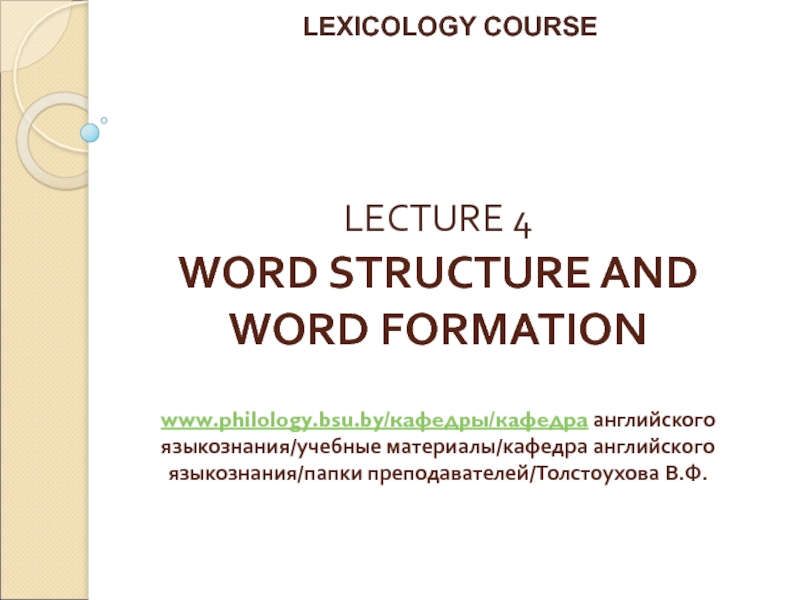
Слайд 2The questions under consideration
1. Morpheme. Allomorph
2. Word Structure
3. Immediate Constituents Analysis
4.
Affixation
5. Conversion
6. Word-Composition
6.1. Properties of compounds
7. Other Types of Word Formation
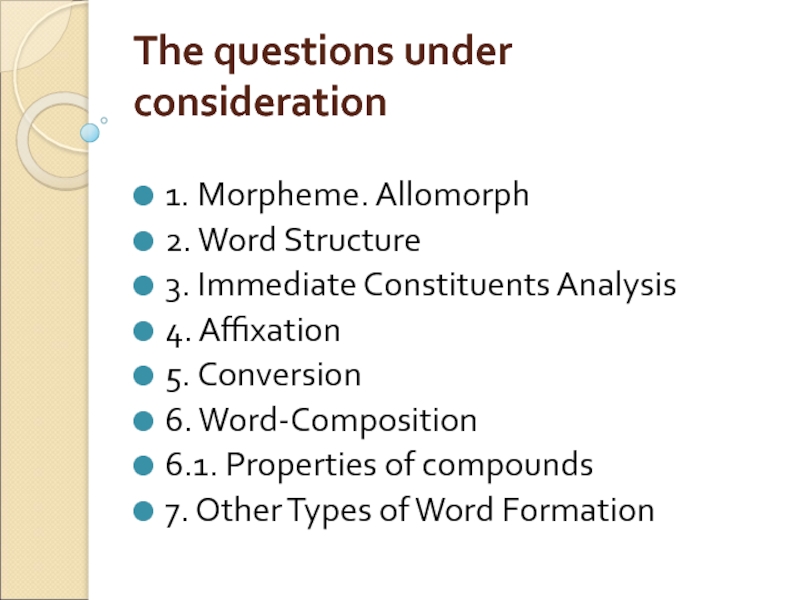
Слайд 3Word-formation (definition)
Word-formation is the branch of lexicology that studies
the derivative
structure of existing words and
the patterns on which a language builds new words.
It is a certain principle of classification of lexicon and
one of the main ways of enriching the vocabulary.
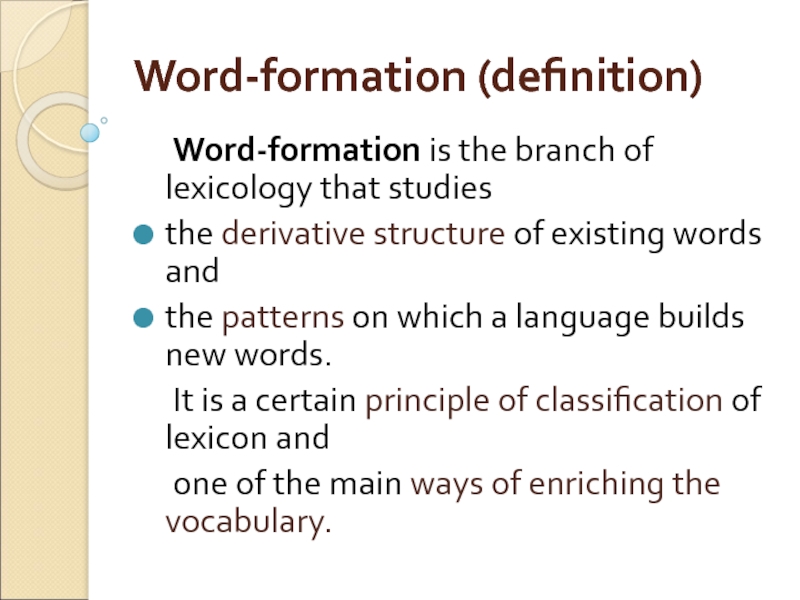
Слайд 4Word-formation is studied
synchronically
Scholars investigate the existing system of the types
of word-formation
Diachronically
Scholars investigate the history of word-formation
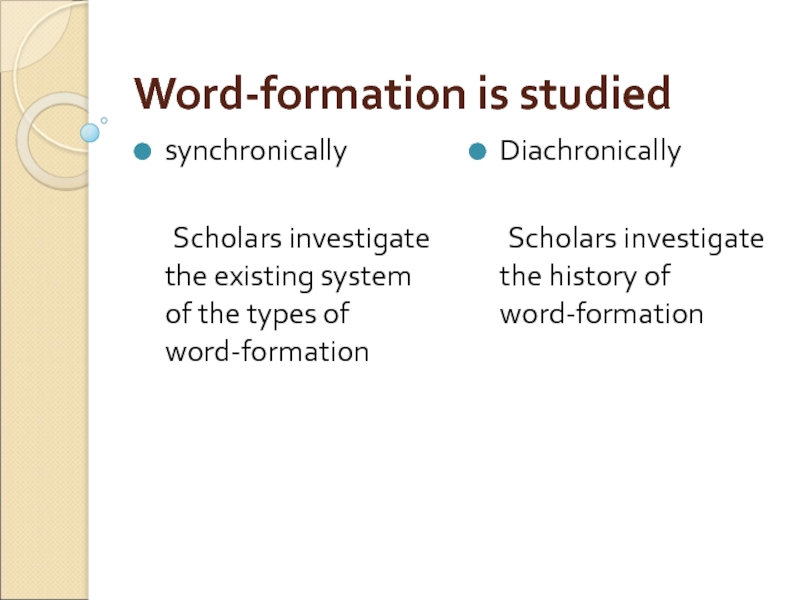
Слайд 51. Morpheme. Allomorph
The smallest unit of language that carries information about
meaning or function is the morpheme.
(Greek morphe «form»
+ -eme «the smallest distinctive unit»)
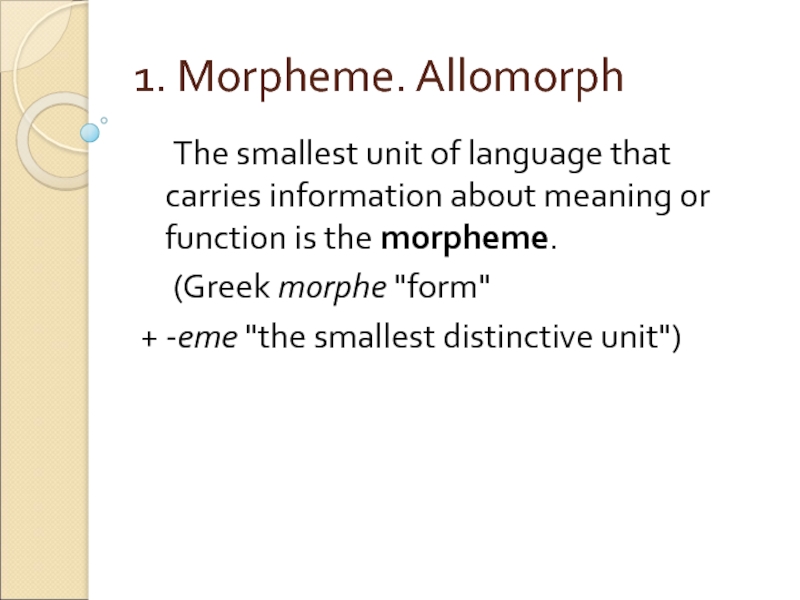
Слайд 6Examples of morphemes
BUILD+ER
build (with the meaning of «construct»)
-er (which indicates that
the entire word functions as a noun with the meaning «one who builds»).
HOUSE+S
house (with the meaning of «dwelling»)
-s (with the meaning «more than one»)
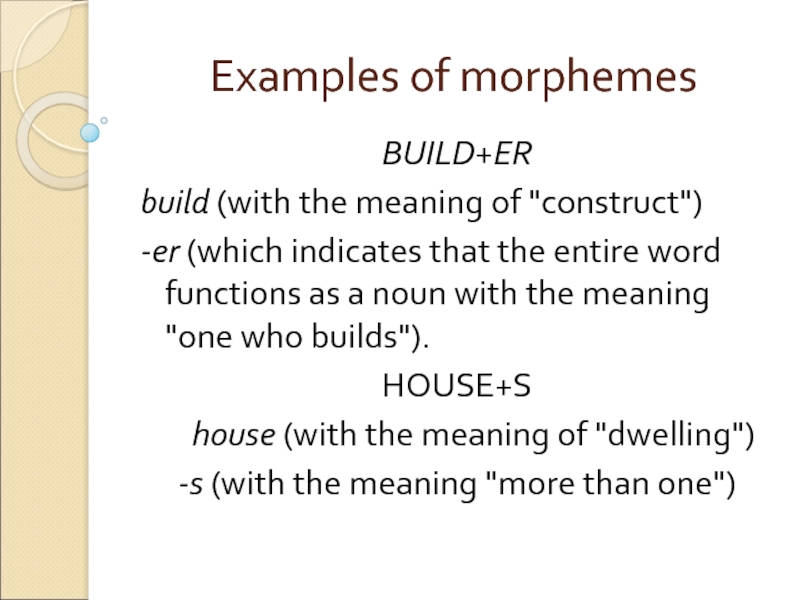
Слайд 7simple words vs complex words
and
boy — boy-s
hunt — hunt-er
—hunt-er-s
act act-ive — act-iv-ate ––re-act-iv-ate
Simple words cannot be divided into smaller parts. Complex words contain two or more morphemes.
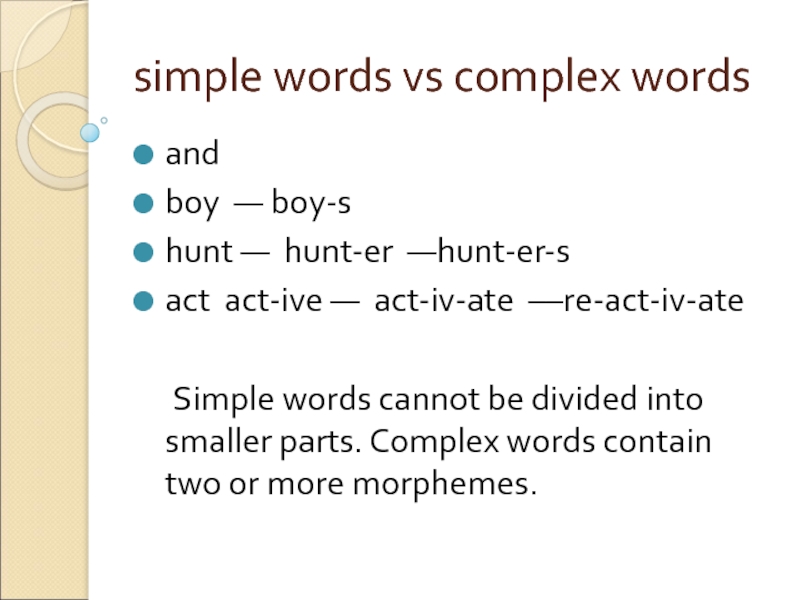
Слайд 8morphemes are two-facet language units
A morpheme is a meaning and a
stretch of sound joined together.
It is the minimum meaningful language unit.
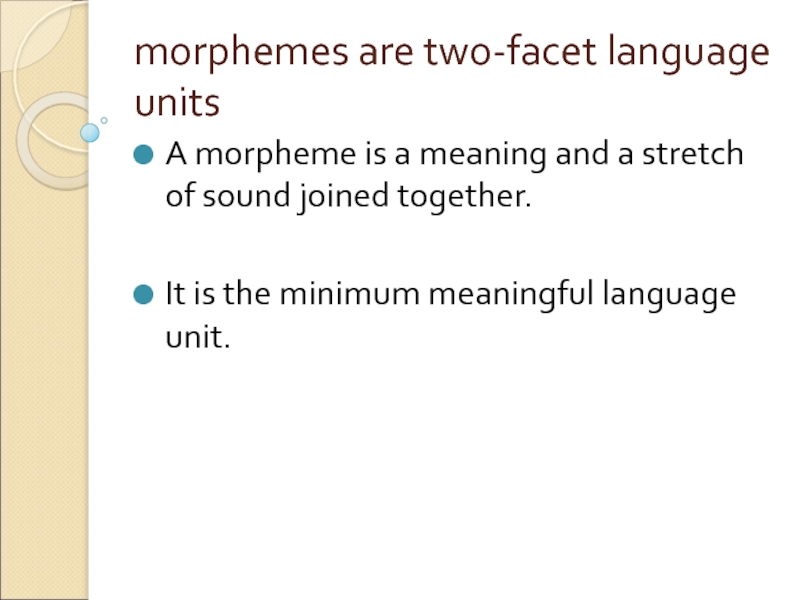
Слайд 9Structure of morphemes
free morpheme
(can be a word by itself,
coincides with the stem or a word-form)
bound morpheme
(must be attached to another element,
only can be a part of a word )
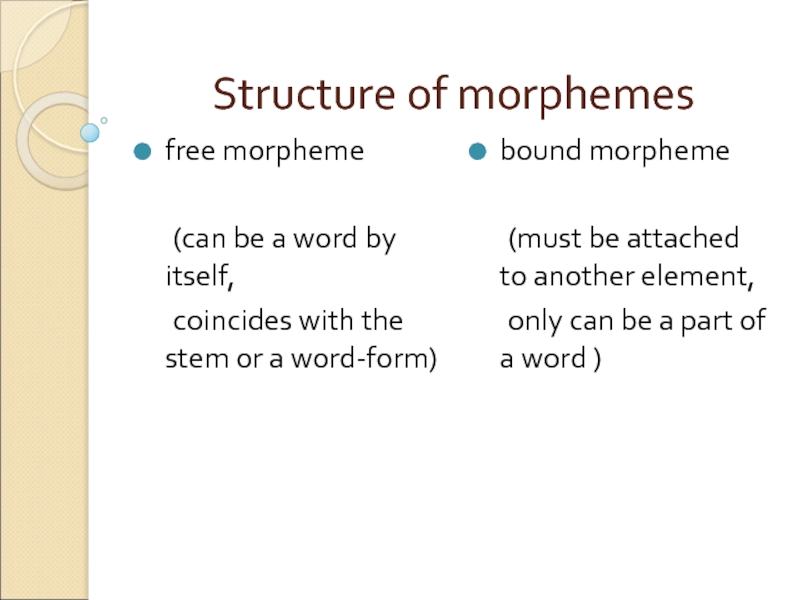
Слайд 10allomorphs (from Greek allos «other»)
All the representatives of the given
morpheme are called allomorphs of that morpheme.
An allomorph is a positional variant of that or this morpheme occurring in a specific environment.

Слайд 11Examples of allomorphs
an orange, an accent, a car
cats, dogs, judges
(the plural morpheme –s)
assert /assert-ion, permit/permiss-ive, include/inclus-ive, electric/electric-ity, impress/impress-ion
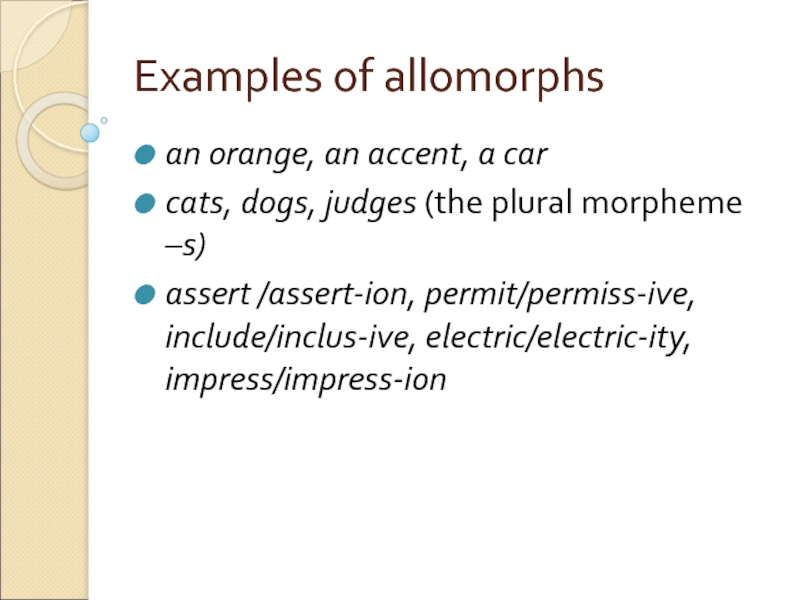
Слайд 122. Word Structure
Words that can be divided have two or more
parts:
a root
affixes (a prefix, a suffix )
inflection
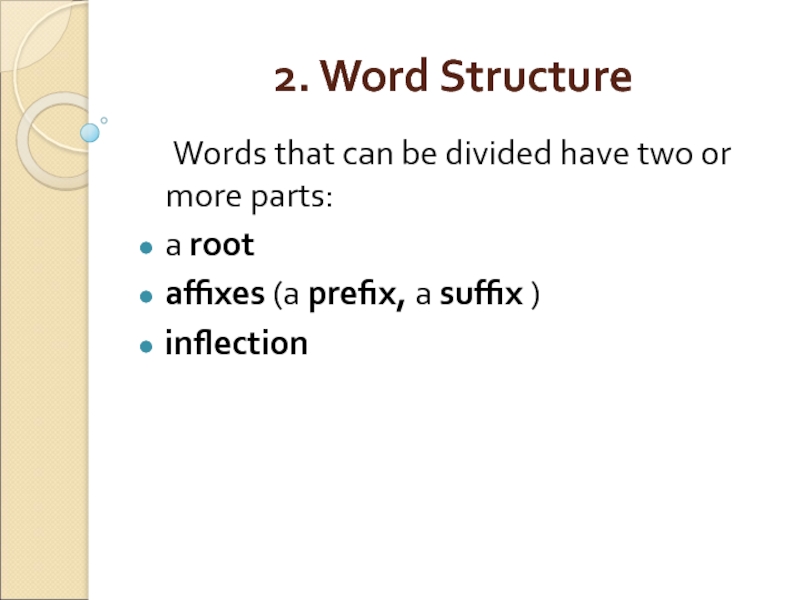
Слайд 13Word Structure
A root constitutes the core of the word and carries
the major component of its meaning. It has more specific and definite meaning
Affixes are morphemes that modify the meaning of the root. An affix added before the root is called a prefix (un-ending); an affix added after the root is called a suffix (kind-ness).
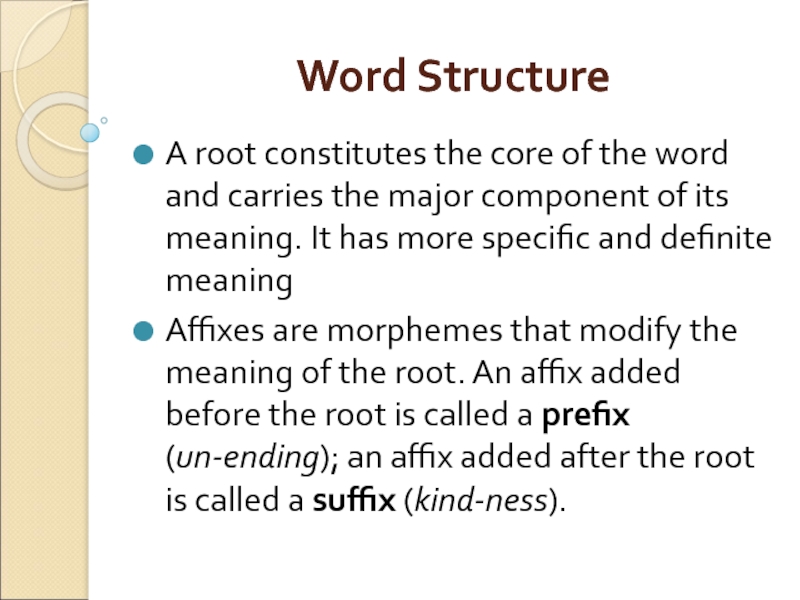
Слайд 14Examples of word structure
un-work-able
govern-ment
fright-en-ing
re-play
A word may have one or more affixes
of either kind, or several of both kinds.
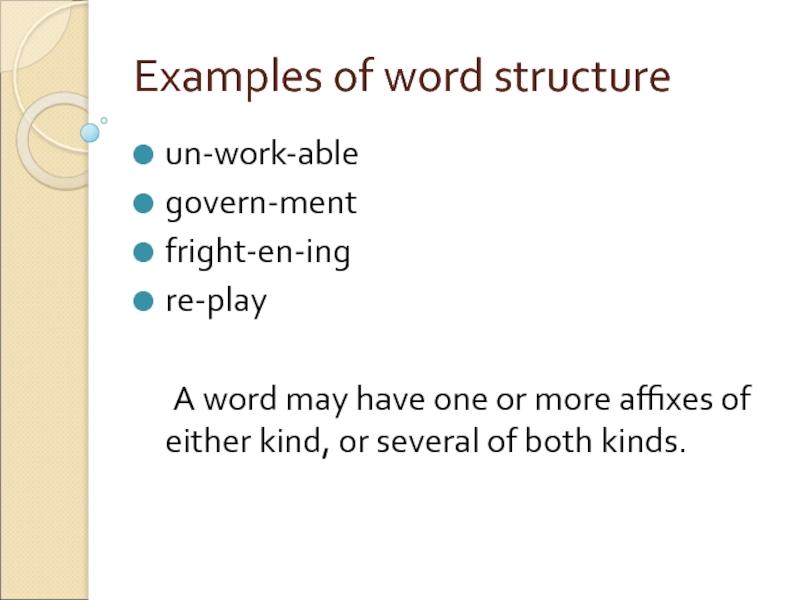
Слайд 15A base
A base is the form to which an affix
is added. In many cases, the base is also the root. In other cases, however, the base can be larger than a root.
Blackened
Blacken (verbal base) +ed
Blacken
Black (not only the root for the entire word but also the base for) +en
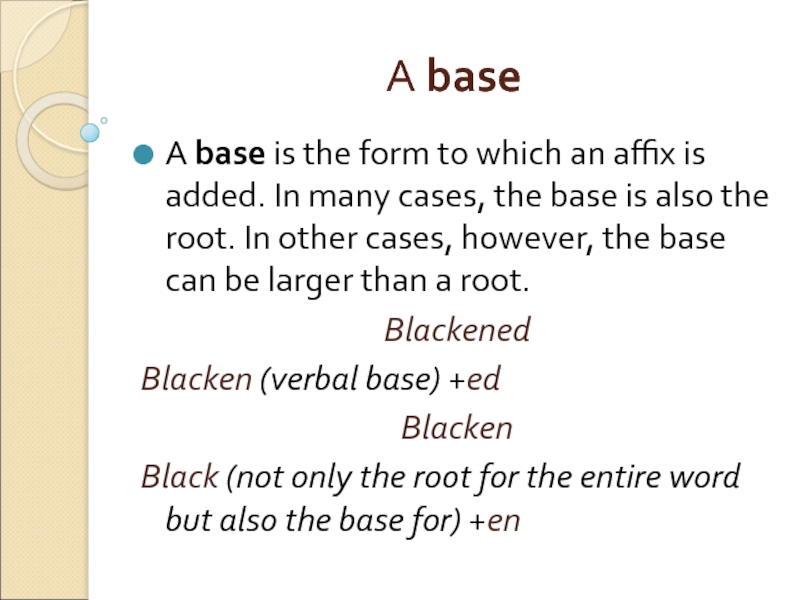
Слайд 16suffixes vs inflections
Suffixes can form a new part of speech,
e.g.: beauty — beautiful. They can also change the meaning of the root, e.g.: black — blackish.
Inflections are morphemes used to change grammar forms of the word, e.g.: work — works — worked—working. English is not a highly inflected language.
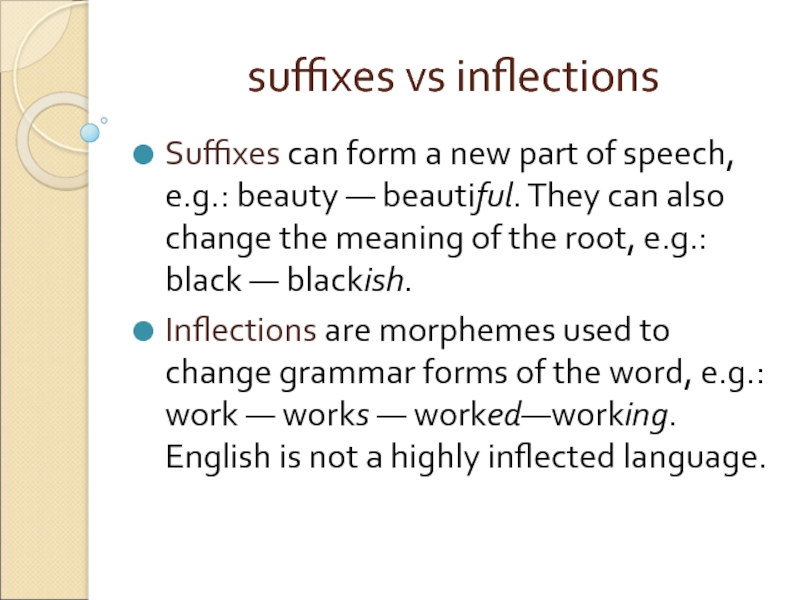
Слайд 17Four structural types of words in English
simple (root) words consist
of one root morpheme and an inflexion (boy, warm, law, tables, tenth);
derived words consist of one root morpheme, one or several affixes and an inflexion (unmanageable, lawful);
compound words consist of two or more root morphemes and an inflexion (boyfriend, outlaw);
compound-derived words consist of two or more root morphemes, one or more affixes and an inflexion (left-handed, warm-hearted, blue-eyed).
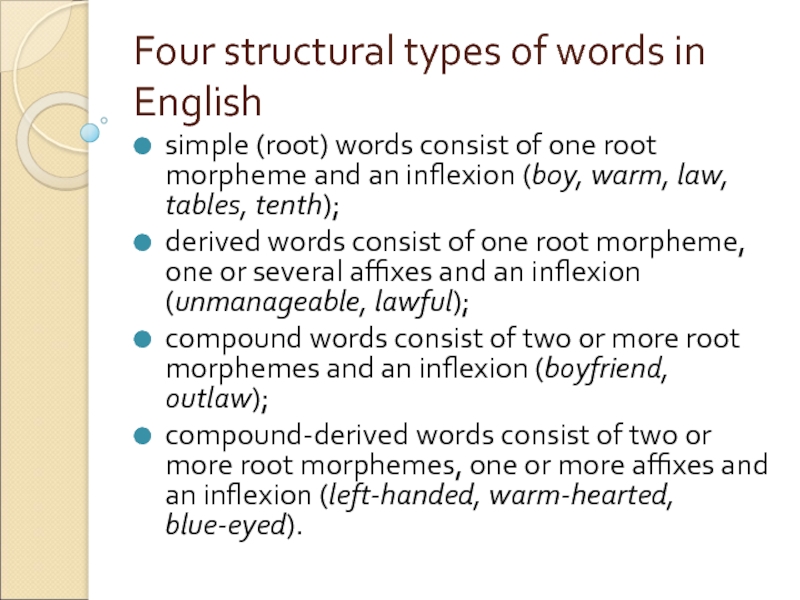
Слайд 18Two main types of word-formation
word-derivation (encouragement, irresistible, worker)
Subdivided into
Affixation
Conversion
Derivational Composition
word-composition (blackboard, daydream, weekend)
Subdivided into
Derivational Composition

Слайд 193. Immediate Constituents Analysis (L. Bloomfield)
Why is it used? (to
discover the derivational structure of lexical units).
How? First we separate a free and a bound forms. At any level we obtain only two ICs.
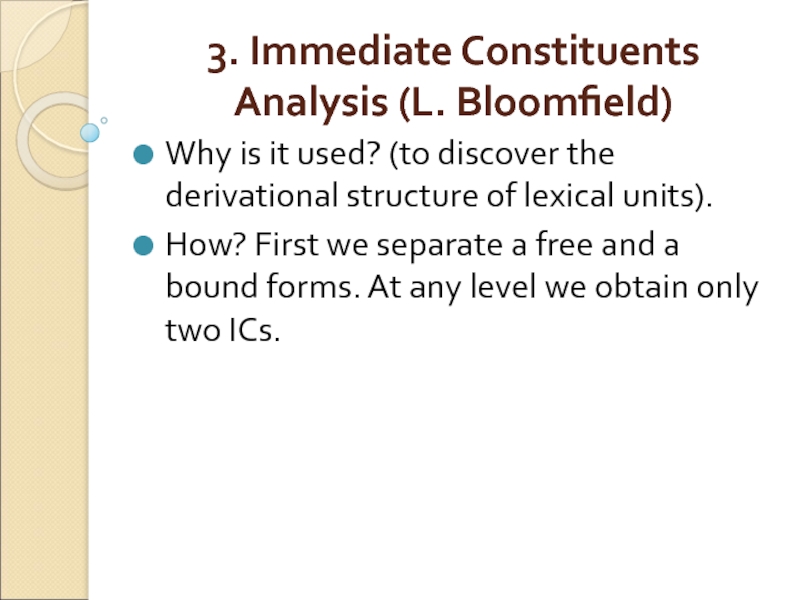
Слайд 20Ungentlemanly
1.un— + gentlemanly
2. gentleman + -ly
3. gentle + man
4.
as a result, un + (gentle + man) + ly
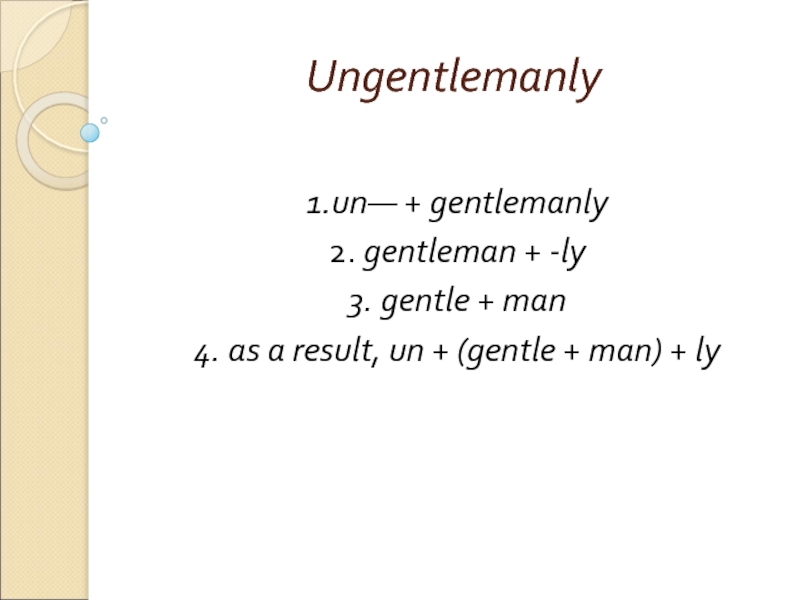
Слайд 21eatable uneatable
The adjective eatable consists of two ICs eat + able
and may be described as a suffixal derivative
the adjective uneatable is a prefixal derivative (the two ICs are un + eatable)
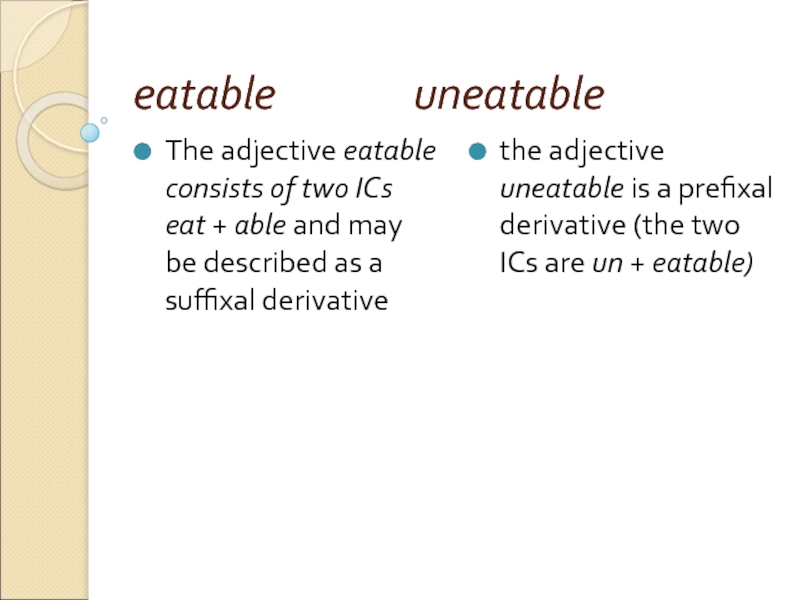
Слайд 224. Affixation
is a basic means of forming words
suffixation
is characteristic of
noun and adjective formation
does not only modify the lexical meaning of the stem,
but transfers the word to another part of speech care (n) / care — less (adj).
prefixation
is typical of verb formation
modifies the lexical meaning of stems
joins the part of speech the unprefixed word belongs to, e.g. usual /un — usual.
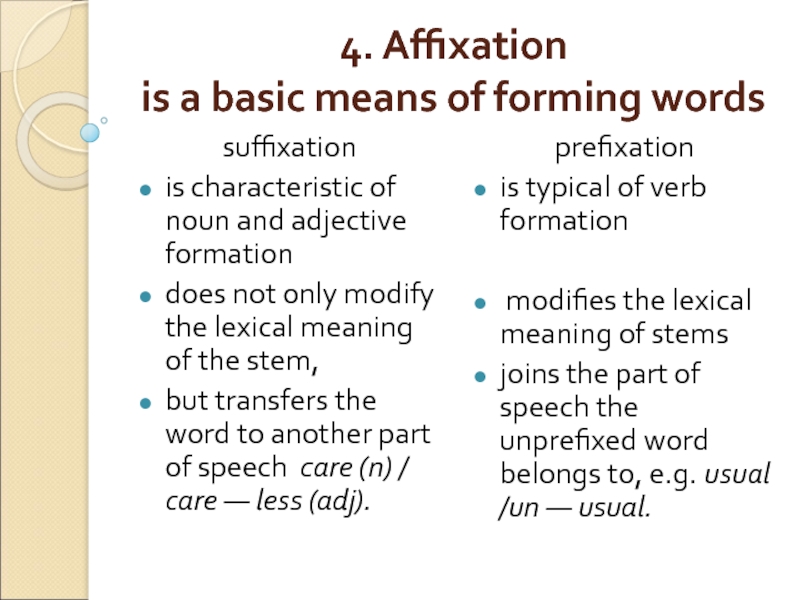
Слайд 23classification of suffixes
their origin
meaning
part of speech they form
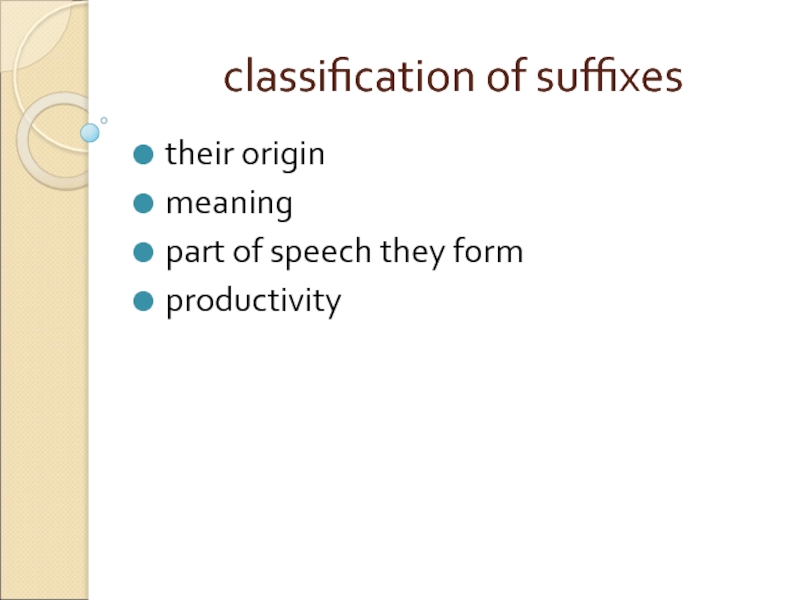
Слайд 24according to their origin:
Romanic (e.g. -age, -ment, -tion),
Native (-er, -dom,
-ship),
Greek (-ism, -ize), etc
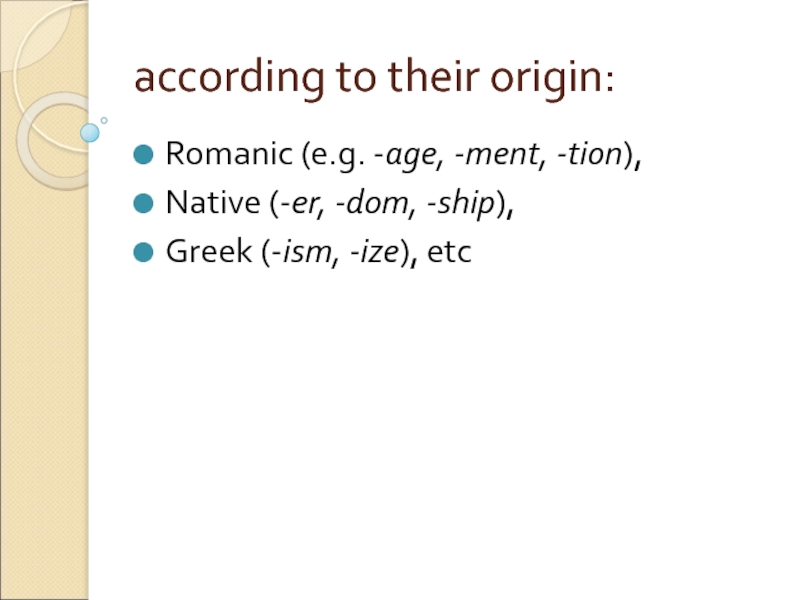
Слайд 25according to their meaning :
-er denotes the agent of the action,
-ess denotes feminine gender,
-ence/ance has abstract meaning,
-age, -dom — collectivity
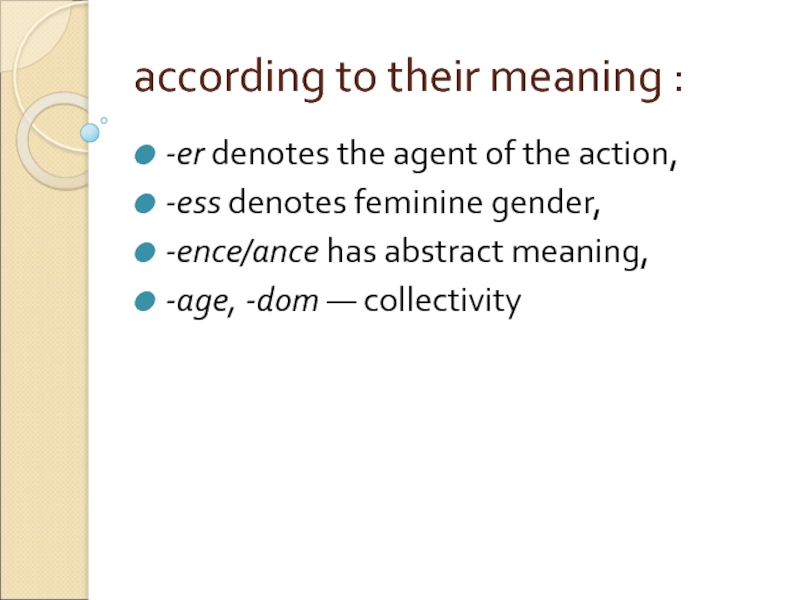
Слайд 26according to their part of speech they form :
noun suffixes -er,
-ness, -ment;
adjective-forming suffixes -ish, -ful, -less, -y;
verb-suffixes -en, -fy,
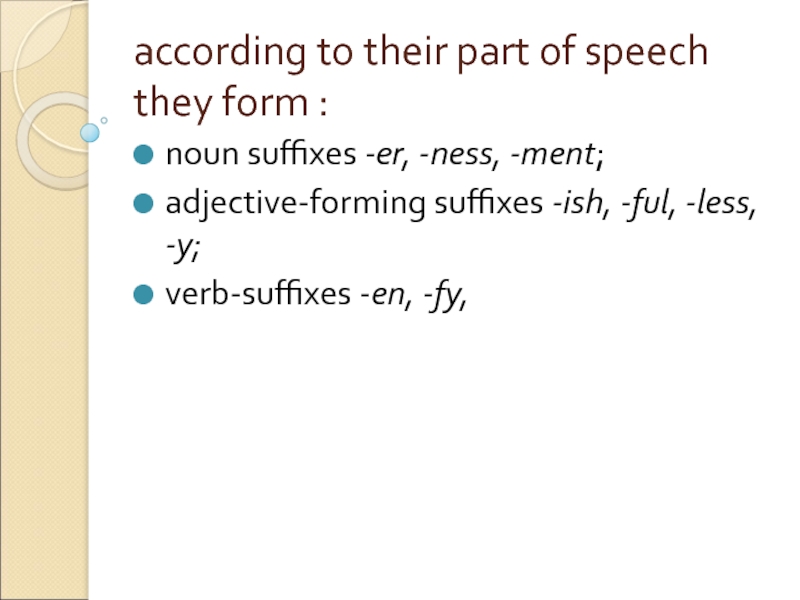
Слайд 27according to their productivity :
What is productivity? It is the relative
freedom with which they can combine with bases of the appropriate category
productive suffixes are -er, -ly, -ness, -ie, -let,
non-productive (-dom, -th)
semi-productive (-eer, -ward).
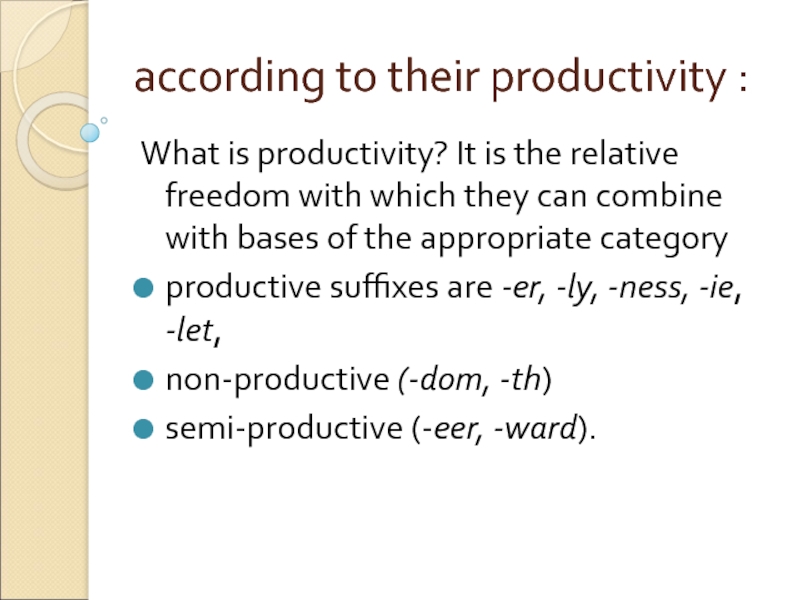
Слайд 28Classification of Prefixes
their origin
meaning
productivity
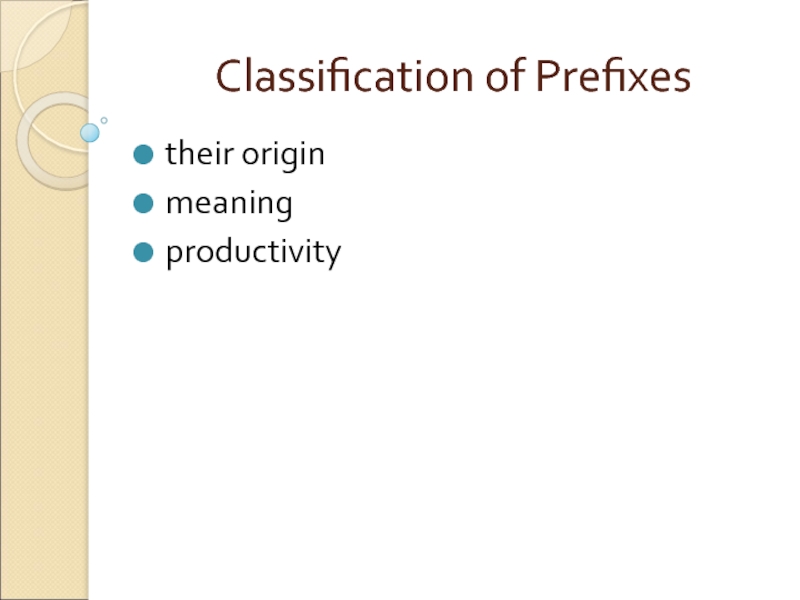
Слайд 29according to their origin:
Native, e.g. un-;
Romanic, e.g. in-;
Greek,
e.g. sym-;
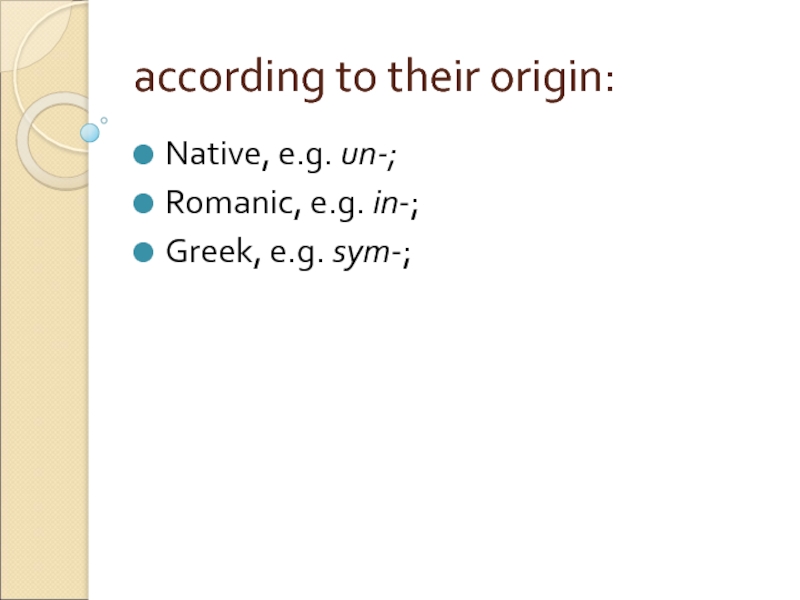
Слайд 30according to meaning
negative prefixes in-, un-, поп-, a-, dis-; prefixes of
time and order ex-, neo-, after-, fore-, post-, proto-;
prefix of repetition re-;
size and degree: hyper-, mega-, mini-, super-, sur-, ultra-, vice-, etc
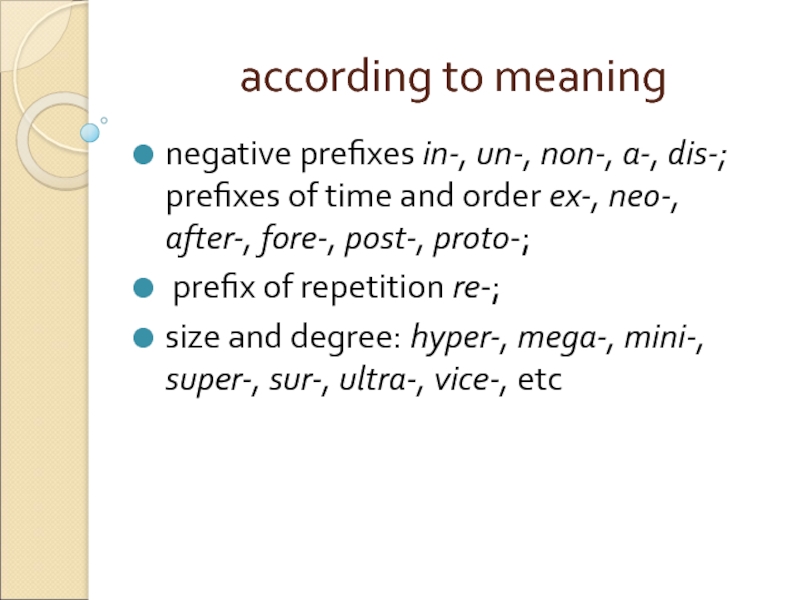
Слайд 31according to productivity
What is productivity? It is the ability to
make new words:
e.g. un- is highly productive.
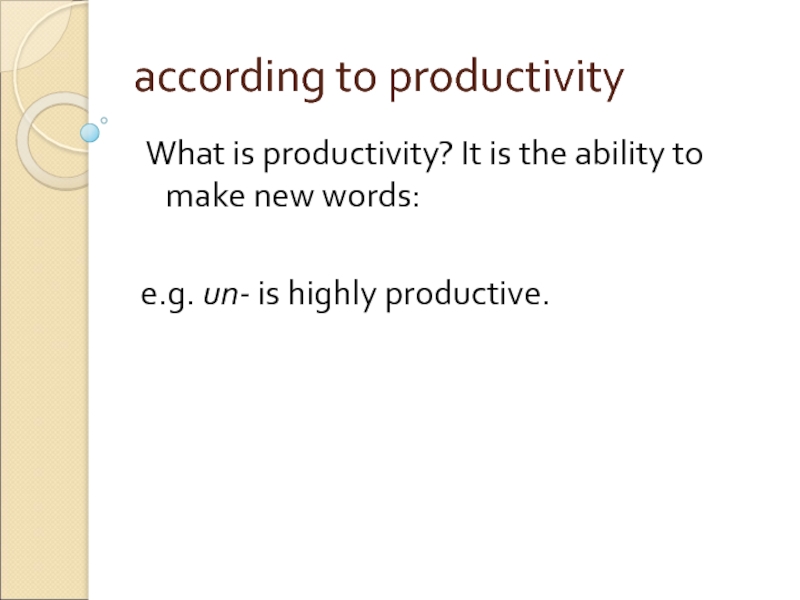
Слайд 325. Conversion (definition)
It is a kind of word formation.
The process of
making new parts of speech without the addition of an affix.
It is a productive way of forming words in English.
It is sometimes called zero derivation.
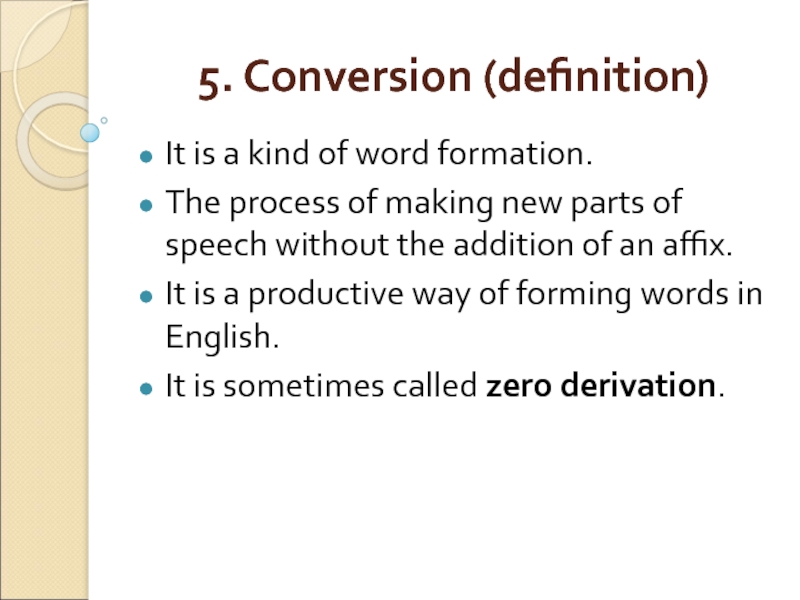
Слайд 33Examples of coversion
He was knocked out in the first round.
Round
the number off to the nearest tenth.
The neighbors gathered round our barbecue.
The moon was bright and round.
People came from all the country round.
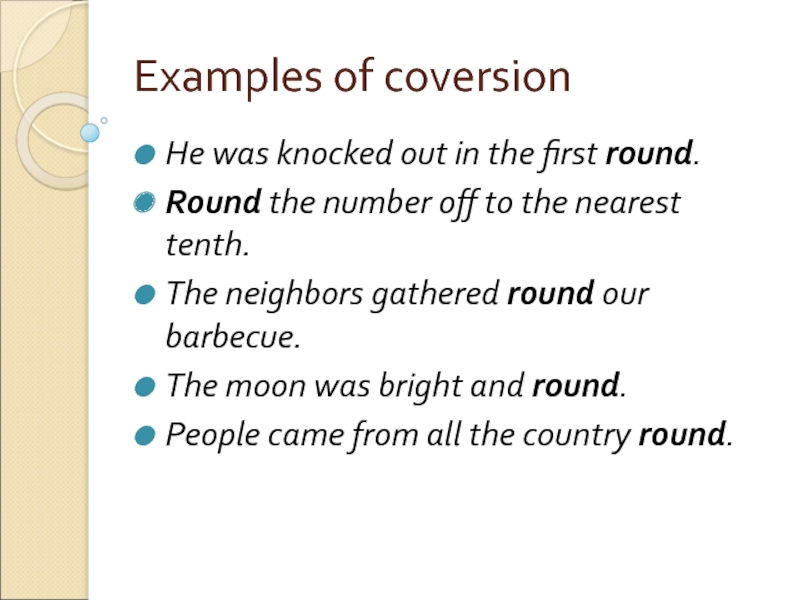
Слайд 34Conversion
Prof. Smirnitsky A. I. in his works on the English language
treats conversion as a morphological way of forming words.
Other linguists (H. Marchand, V.N. Yartseva, Yu.A. Zhluktenko, A.Y. Zagoruiko, I.V. Arnold) treat conversion as a combined morphological and syntactic way of word-building, as a new word appears not in isolation but in a definite environment of other words.
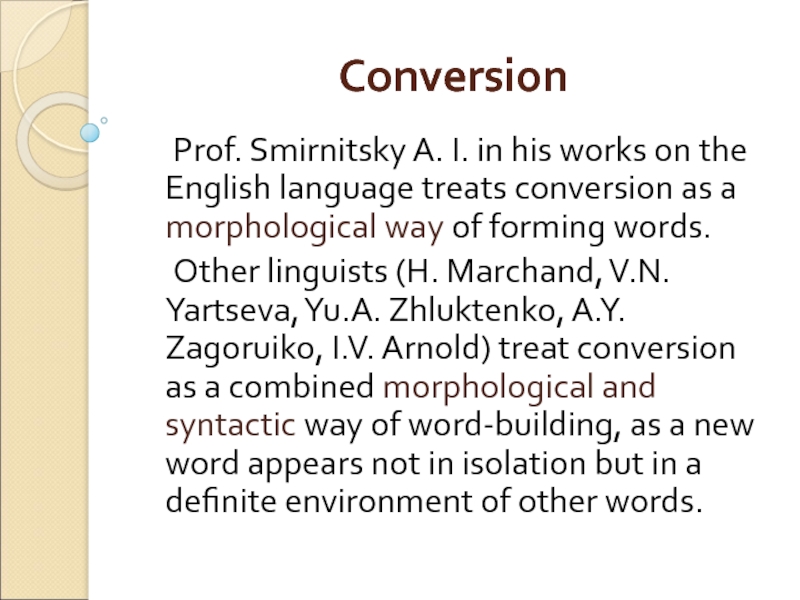
Слайд 35The three most common types of conversion
verbs derived from nouns
(to butter, to ship),
nouns derived from verbs (a survey, a call),
verbs derived from adjectives (to empty).
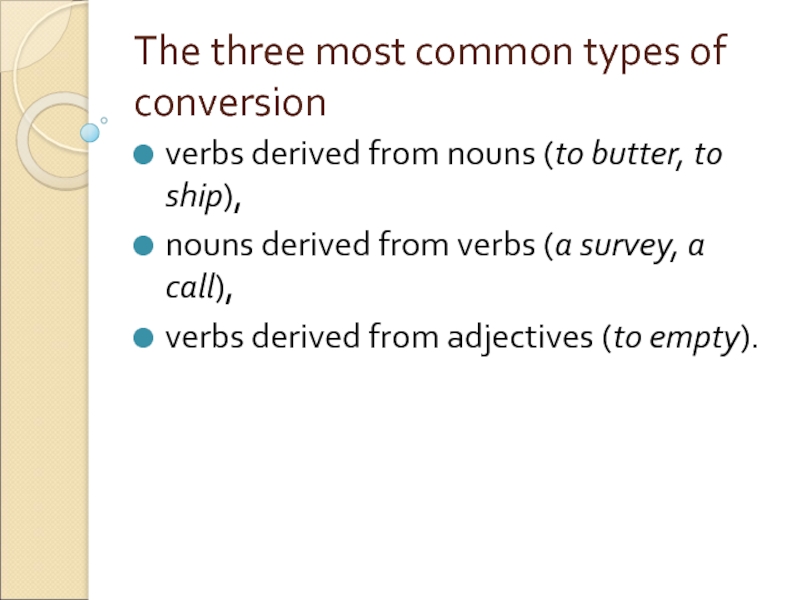
Слайд 36Less common types of conversion
nouns from:
adjectives (a bitter, the
poor, a final),
from phrases, e.g. a down-and-out,
verbs from prepositions (up the price, out e.g. diplomats were outed from the country; Truth will out. — Истина станет известной)

Слайд 37Verbs converted from nouns
instrumental use of the object, e.g. screw
— to screw, eye — to eye;
action characteristic of the object, e.g. ape — to ape;
acquisition: fish — to fish;
deprivation of the object, e.g. dust — to dust
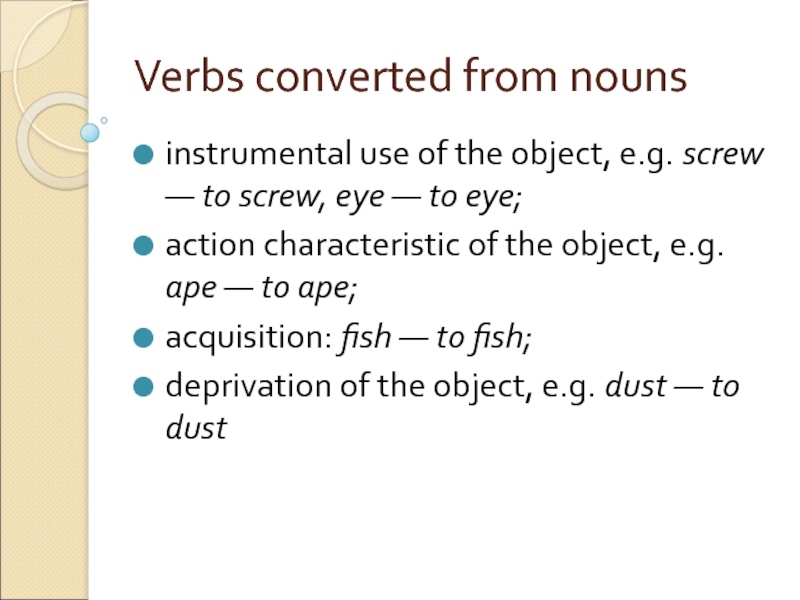
Слайд 38Nouns converted from verbs
instance of an action, e.g. to move
— a move;
word — agent of an action, e.g. to bore — a bore;
place of an action, e.g. to walk — a walk;
result of the action, e.g. to cut — a cut
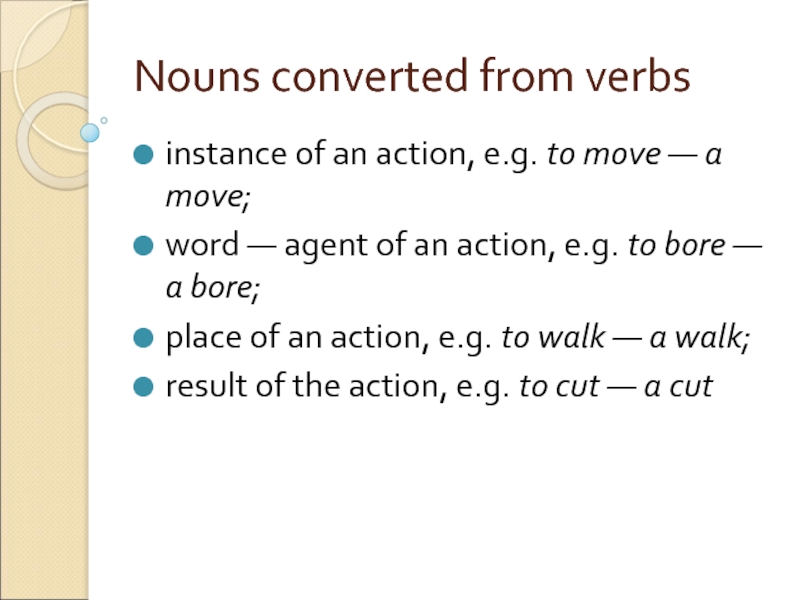
Слайд 396.Word-Composition
Word-composition is the combination of two or more existing words to
create a new word
e.g. campsite (N+N), bluebird (A+N), whitewash (A+V), in-laws (P+N), jumpsuit (V+N).
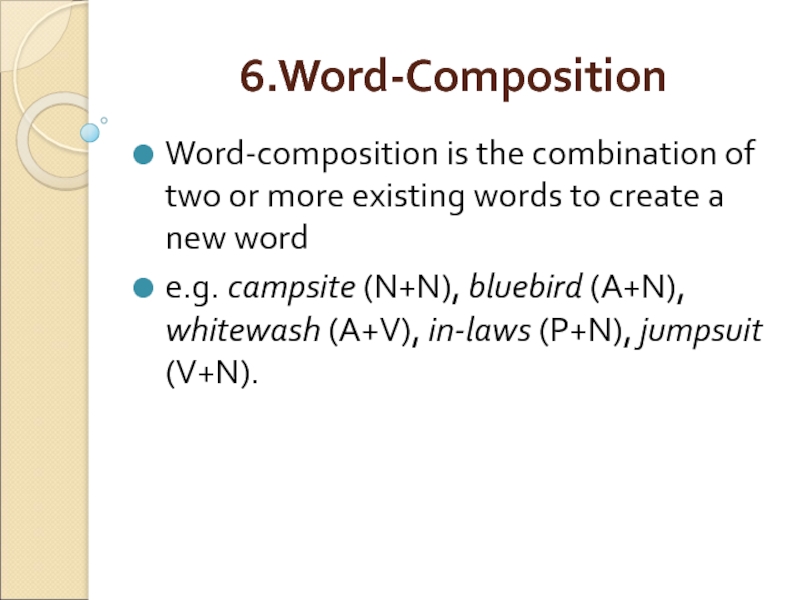
Слайд 40Word-Composition
In most compounds the rightmost morpheme determines the category of the
entire word,
e.g. greenhouse is a noun because its rightmost component is a noun, spoonfeed is a verb because feed also belongs to this category, and
nationwide is an adjective just as wide is.
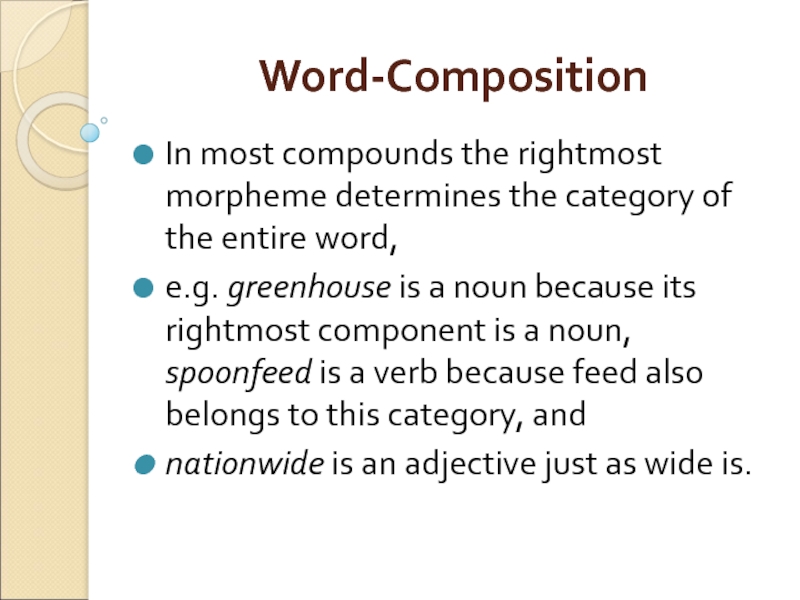
Слайд 416.1. Properties of compounds
How can compounds in English be written? —
Differently:
as single words,
with an intervening hyphen,
as separate words.
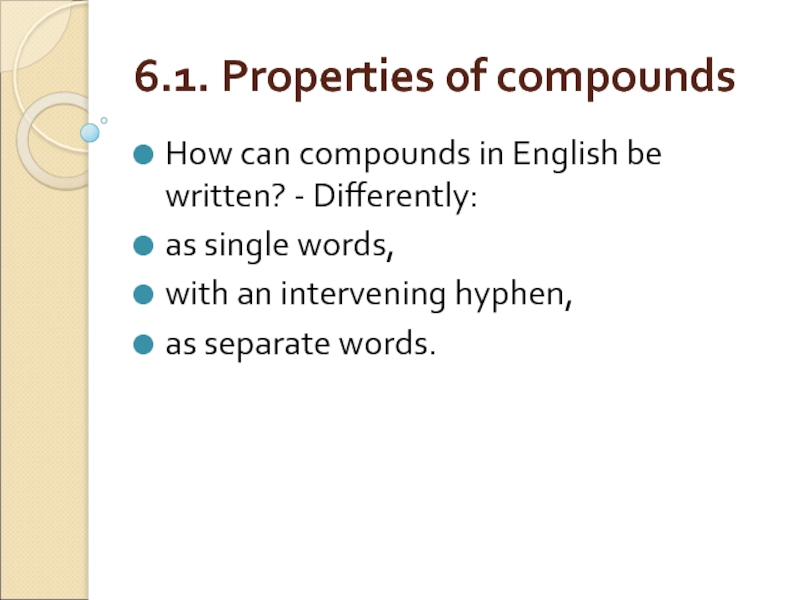
Слайд 42endocentric compounds
If a compound denotes a subtype of the concept
denoted by its head it is called endocentric.
Thus, cat food is a type of food, sky blue is a type of blue
airplane, steamboat, policeman, bathtowel
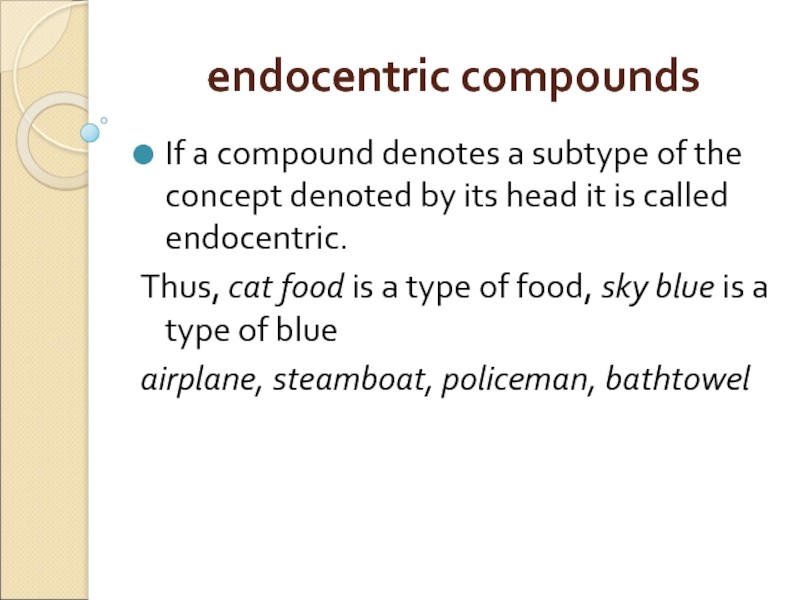
Слайд 43exocentric compounds
If the meaning of the compound does not follow
from the meanings of its parts it is said to be exocentric
e.g. redneck is a person and not a type of neck;
walkman is a type of portable radio.

Слайд 44Classification of compounds according to the principle
1) of the parts
of speech compound words represent:
nouns: night-gown, waterfall, looking-glass;
verbs: to honeymoon, to outgrow;
adjectives: peace-loving, hard-working, pennywise;
adverbs: downstairs, lip-deep;
prepositions: within, into, onto;
numerals: thirty-seven;
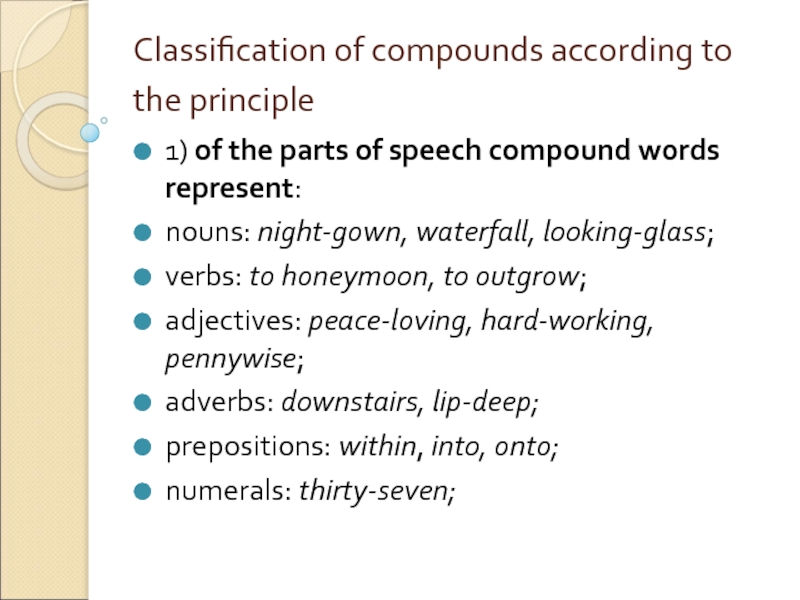
Слайд 45Classification of compounds according to the principle
2.of the means of composition
used to link the two ICs together:
neutral — formed by joining together two stems without connecting elements (juxtaposition), e.g. scarecrow, goldfish, crybaby;
morphological — components are joined by a linking element, i.e. vowels ‘o’ and ‘i’ or the consonant ‘s’, e.g. videophone, tragicomic, handicraft, craftsman, microchip;
syntactical — the components are joined by means of form-word stems, e.g. man-of-war, forget-me-not, bread-and-butter, face-to-face;
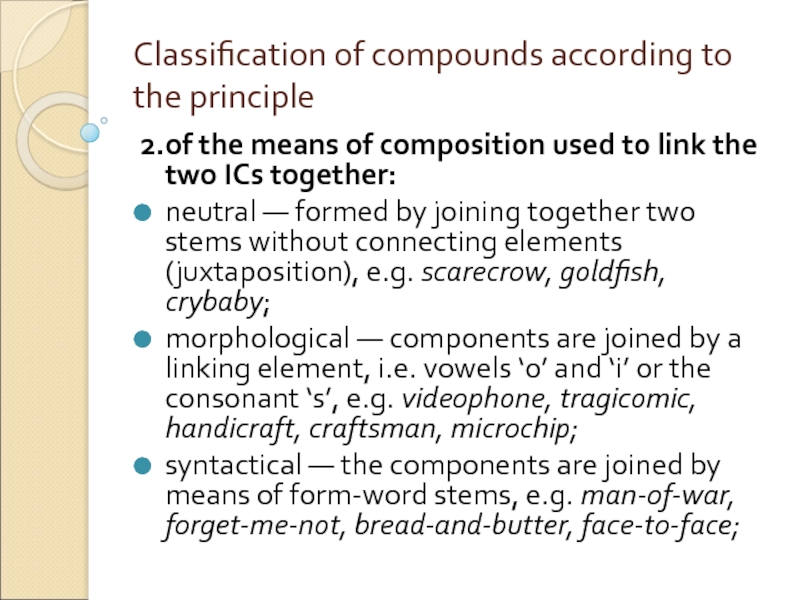
Слайд 467. Other Types of Word Formation
back-formation or disaffixation (baby-sitter —
to baby-sit). Back-formation is a process that creates a new word by removing a real or supposed affix from another word in the language.
sound interchange (speak — speech, blood — bleed), and sound imitation (walkie-talkie, brag rags, to giggle);
distinctive change (‘conduct — to con ‘duct, ‘increase — to in crease, ‘subject — to subject);
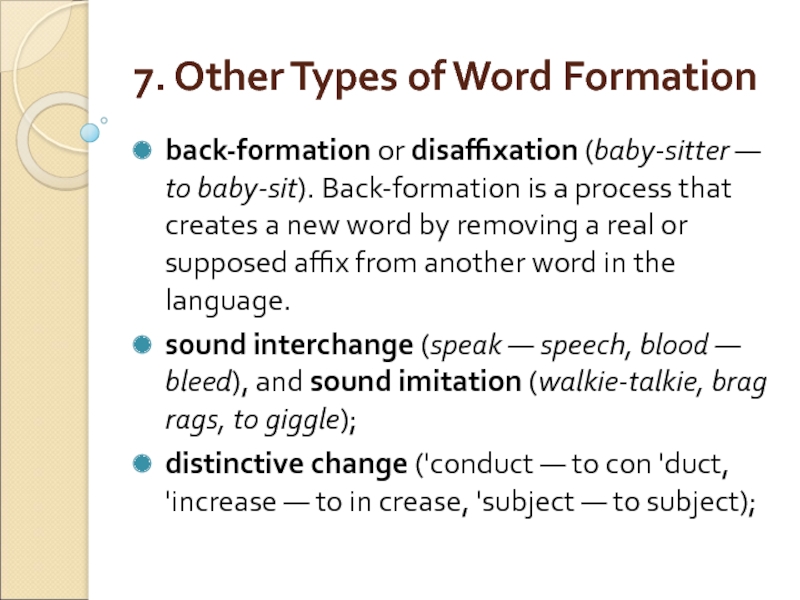
Слайд 47Other Types of Word Formation
blending: these are words that are created
from parts of two already existing items, usually the first part of one and the final part of the other:
brunch from breakfast and lunch,
smog from smoke and fog
clipping is a process that shortens a polysyllabic word by deleting one or more syllables: prof for professor, burger for hamburger.
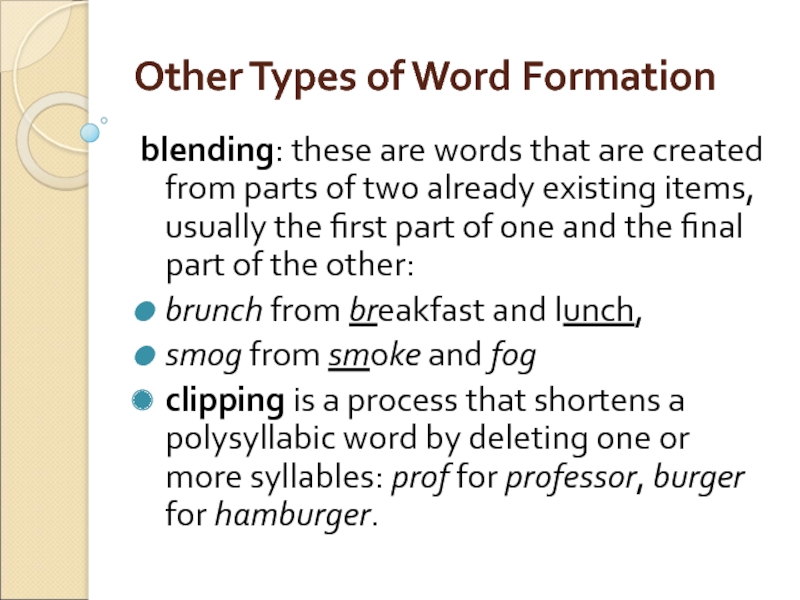
Слайд 48Other Types of Word Formation
acronymy: NATO, NASA, WAC, UNESCO. Acronyms are
formed by taking the initial letters of the words in a phrase and pronouncing them as a word. (names of organizations and in terminology).
NASA stands for National Aeronautics and Space Administration, NA TO — North Atlantic Treaty Organization
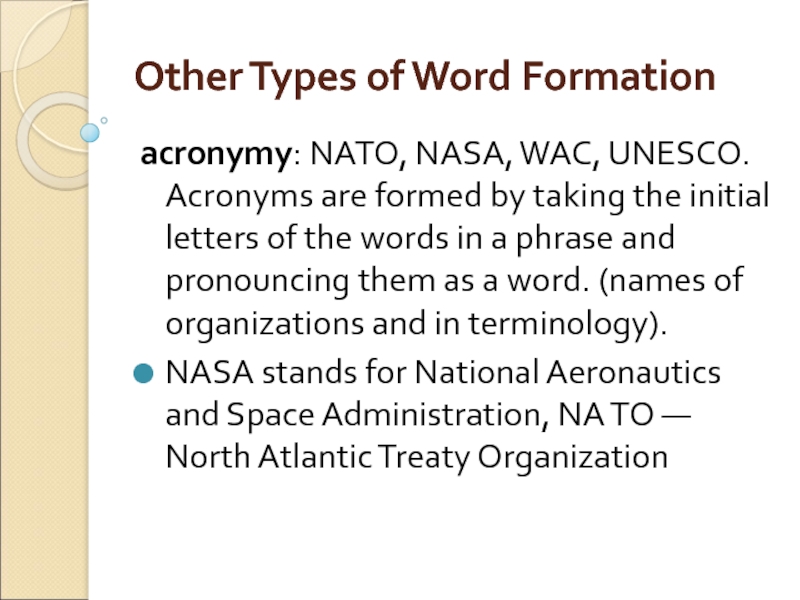
Слайд 49Other Types of Word Formation
onomatopoeia, i.e. formations of words from sounds
that resemble those associated with the object or action to be named, or that seem suggestive of its qualities.
e.g. hiss, buzz, meow, cock-a-doodle-doo, and cuckoo
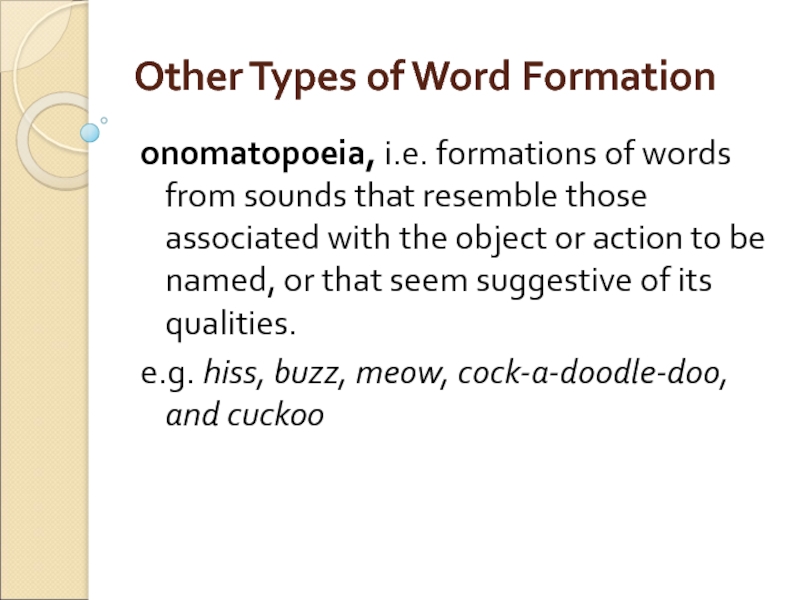
1. LECTURE 4 WORD STRUCTURE AND WORD FORMATION www.philology.bsu.by/кафедры/кафедра английского языкознания/учебные материалы/кафедра английского языкознания/папки преп
LEXICOLOGY COURSE
LECTURE 4
WORD STRUCTURE AND
WORD FORMATION
www.philology.bsu.by/кафедры/кафедра английского
языкознания/учебные материалы/кафедра английского
языкознания/папки преподавателей/Толстоухова В.Ф.
2. The questions under consideration
1. Morpheme. Allomorph
2. Word Structure
3. Immediate Constituents Analysis
4. Affixation
5. Conversion
6. Word-Composition
6.1. Properties of compounds
7. Other Types of Word Formation
3. Word-formation (definition)
Word-formation is the branch of
lexicology that studies
the derivative structure of existing words
and
the patterns on which a language builds
new words.
It is a certain principle of classification of
lexicon and
one of the main ways of enriching the
vocabulary.
4. Word-formation is studied
synchronically
Scholars investigate
the existing system
of the types of wordformation
Diachronically
Scholars investigate
the history of wordformation
5. 1. Morpheme. Allomorph
The smallest unit of language that carries
information about meaning or function is
the morpheme.
(Greek morphe «form»
+ -eme «the smallest distinctive unit»)
6. Examples of morphemes
BUILD+ER
build (with the meaning of «construct»)
-er (which indicates that the entire word
functions as a noun with the meaning
«one who builds»).
HOUSE+S
house (with the meaning of «dwelling»)
-s (with the meaning «more than one»)
7. simple words vs complex words
and
boy — boy-s
hunt — hunt-er —hunt-er-s
act act-ive — act-iv-ate ––re-act-iv-ate
Simple words cannot be divided into
smaller parts. Complex words contain
two or more morphemes.
8. morphemes are two-facet language units
A morpheme is a meaning and a stretch
of sound joined together.
It is the minimum meaningful language
unit.
9. Structure of morphemes
free morpheme
(can be a word by
itself,
coincides with the
stem or a word-form)
bound morpheme
(must be attached to
another element,
only can be a part of
a word )
10. allomorphs (from Greek allos «other»)
allomorphs (from Greek allos
«other»)
All the representatives of the given
morpheme are called allomorphs of that
morpheme.
An allomorph is a positional variant of
that or this morpheme occurring in a
specific environment.
11. Examples of allomorphs
an orange, an accent, a car
cats, dogs, judges (the plural morpheme –
s)
assert /assert-ion, permit/permiss-ive,
include/inclus-ive, electric/electric-ity,
impress/impress-ion
12. 2. Word Structure
Words that can be divided have two or
more parts:
a root
affixes (a prefix, a suffix )
inflection
13. Word Structure
A root constitutes the core of the word
and carries the major component of its
meaning. It has more specific and
definite meaning
Affixes are morphemes that modify the
meaning of the root. An affix added
before the root is called a prefix (unending); an affix added after the root is
called a suffix (kind-ness).
14. Examples of word structure
un-work-able
govern-ment
fright-en-ing
re-play
A word may have one or more affixes of
either kind, or several of both kinds.
15. A base
A base is the form to which an affix is
added. In many cases, the base is also the
root. In other cases, however, the base
can be larger than a root.
Blackened
Blacken (verbal base) +ed
Blacken
Black (not only the root for the entire word
but also the base for) +en
16. suffixes vs inflections
Suffixes can form a new part of speech,
e.g.: beauty — beautiful. They can also
change the meaning of the root, e.g.:
black — blackish.
Inflections are morphemes used to
change grammar forms of the word, e.g.:
work — works — worked—working.
English is not a highly inflected language.
17. Four structural types of words in English
simple (root) words consist of one root
morpheme and an inflexion (boy, warm, law,
tables, tenth);
derived words consist of one root
morpheme, one or several affixes and an
inflexion (unmanageable, lawful);
compound words consist of two or more root
morphemes and an inflexion (boyfriend,
outlaw);
compound-derived words consist of two or
more root morphemes, one or more affixes
and an inflexion (left-handed, warm-hearted,
blue-eyed).
18. Two main types of word-formation
word-derivation
(encouragement,
irresistible, worker)
Subdivided into
Affixation
Conversion
Derivational
Composition
word-composition
(blackboard,
daydream, weekend)
Subdivided into
• Derivational
Composition
19. 3. Immediate Constituents Analysis (L. Bloomfield)
Why is it used? (to discover the
derivational structure of lexical units).
How? First we separate a free and a
bound forms. At any level we obtain only
two ICs.
20. Ungentlemanly
1.un— + gentlemanly
2. gentleman + -ly
3. gentle + man
4. as a result, un + (gentle + man) + ly
21. eatable uneatable
eatable
The adjective eatable
consists of two ICs
eat + able and may
be described as a
suffixal derivative
uneatable
the adjective
uneatable is a
prefixal derivative
(the two ICs are un +
eatable)
22. 4. Affixation is a basic means of forming words
suffixation
• is characteristic of
noun and adjective
formation
• does not only modify
the lexical meaning
of the stem,
• but transfers the
word to another part
of speech care (n) /
care — less (adj).
prefixation
• is typical of verb
formation
modifies the lexical
meaning of stems
• joins the part of
speech the
unprefixed word
belongs to, e.g. usual
/un — usual.
23. classification of suffixes
their origin
meaning
part of speech they form
productivity
24. according to their origin:
Romanic (e.g. -age, -ment, -tion),
Native (-er, -dom, -ship),
Greek (-ism, -ize), etc
25. according to their meaning :
-er denotes the agent of the action,
-ess denotes feminine gender,
-ence/ance has abstract meaning,
-age, -dom — collectivity
26. according to their part of speech they form :
noun suffixes -er, -ness, -ment;
adjective-forming suffixes -ish, -ful, -less,
-y;
verb-suffixes -en, -fy,
27. according to their productivity :
What is productivity? It is the relative
freedom with which they can combine
with bases of the appropriate category
productive suffixes are -er, -ly, -ness, ie, -let,
non-productive (-dom, -th)
semi-productive (-eer, -ward).
28. Classification of Prefixes
their origin
meaning
productivity
29. according to their origin:
Native, e.g. un-;
Romanic, e.g. in-;
Greek, e.g. sym-;
30. according to meaning
negative prefixes in-, un-, поп-, a-, dis-;
prefixes of time and order ex-, neo-, after, fore-, post-, proto-;
prefix of repetition re-;
size and degree: hyper-, mega-, mini-,
super-, sur-, ultra-, vice-, etc
31. according to productivity
What is productivity? It is the ability to
make new words:
e.g. un- is highly productive.
32. 5. Conversion (definition)
It is a kind of word formation.
The process of making new parts of
speech without the addition of an affix.
It is a productive way of forming words
in English.
It is sometimes called zero derivation.
33. Examples of coversion
He was knocked out in the first round.
Round the number off to the nearest
tenth.
The neighbors gathered round our
barbecue.
The moon was bright and round.
People came from all the country round.
34. Conversion
Prof. Smirnitsky A. I. in his works on the
English language treats conversion as a
morphological way of forming words.
Other linguists (H. Marchand, V.N.
Yartseva, Yu.A. Zhluktenko, A.Y.
Zagoruiko, I.V. Arnold) treat conversion
as a combined morphological and
syntactic way of word-building, as a new
word appears not in isolation but in a
definite environment of other words.
35. The three most common types of conversion
verbs derived from nouns (to butter, to
ship),
nouns derived from verbs (a survey, a
call),
verbs derived from adjectives (to empty).
36. Less common types of conversion
nouns from:
adjectives (a bitter, the poor, a final),
from phrases, e.g. a down-and-out,
verbs from prepositions (up the price, out
e.g. diplomats were outed from the
country; Truth will out. — Истина станет
известной)
37. Verbs converted from nouns
instrumental use of the object, e.g.
screw — to screw, eye — to eye;
action characteristic of the object, e.g.
ape — to ape;
acquisition: fish — to fish;
deprivation of the object, e.g. dust — to
dust
38. Nouns converted from verbs
instance of an action, e.g. to move — a
move;
word — agent of an action, e.g. to bore
— a bore;
place of an action, e.g. to walk — a
walk;
result of the action, e.g. to cut — a cut
39. 6.Word-Composition
Word-composition is the combination of
two or more existing words to create a
new word
e.g. campsite (N+N), bluebird (A+N),
whitewash (A+V), in-laws (P+N), jumpsuit
(V+N).
40. Word-Composition
In most compounds the rightmost
morpheme determines the category of
the entire word,
e.g. greenhouse is a noun because its
rightmost component is a noun,
spoonfeed is a verb because feed also
belongs to this category, and
nationwide is an adjective just as wide is.
41. 6.1. Properties of compounds
How can compounds in English be
written? — Differently:
as single words,
with an intervening hyphen,
as separate words.
42. endocentric compounds
If a compound denotes a subtype of the
concept denoted by its head it is called
endocentric.
Thus, cat food is a type of food, sky blue is a
type of blue
airplane, steamboat, policeman, bathtowel
43. exocentric compounds
If the meaning of the compound does not
follow from the meanings of its parts it is
said to be exocentric
e.g. redneck is a person and not a type of
neck;
walkman is a type of portable radio.
44. Classification of compounds according to the principle
1) of the parts of speech compound words
represent:
nouns: night-gown, waterfall, looking-glass;
verbs: to honeymoon, to outgrow;
adjectives: peace-loving, hard-working,
pennywise;
adverbs: downstairs, lip-deep;
prepositions: within, into, onto;
numerals: thirty-seven;
45. Classification of compounds according to the principle
2.of the means of composition used to link the
two ICs together:
neutral — formed by joining together two
stems without connecting elements
(juxtaposition), e.g. scarecrow, goldfish,
crybaby;
morphological — components are joined by a
linking element, i.e. vowels ‘o’ and ‘i’ or the
consonant ‘s’, e.g. videophone, tragicomic,
handicraft, craftsman, microchip;
syntactical — the components are joined by
means of form-word stems, e.g. man-of-war,
forget-me-not, bread-and-butter, face-to-face;
46. 7. Other Types of Word Formation
back-formation or disaffixation (baby-sitter —
to baby-sit). Back-formation is a process that
creates a new word by removing a real or
supposed affix from another word in the
language.
sound interchange (speak — speech, blood —
bleed), and sound imitation (walkie-talkie, brag
rags, to giggle);
distinctive change (‘conduct — to con ‘duct,
‘increase — to in crease, ‘subject — to subject);
47. Other Types of Word Formation
blending: these are words that are created
from parts of two already existing items,
usually the first part of one and the final
part of the other:
brunch from breakfast and lunch,
smog from smoke and fog
clipping is a process that shortens a
polysyllabic word by deleting one or
more syllables: prof for professor, burger
for hamburger.
48. Other Types of Word Formation
acronymy: NATO, NASA, WAC, UNESCO.
Acronyms are formed by taking the initial
letters of the words in a phrase and
pronouncing them as a word. (names of
organizations and in terminology).
NASA stands for National Aeronautics
and Space Administration, NA TO —
North Atlantic Treaty Organization
49. Other Types of Word Formation
onomatopoeia, i.e. formations of words
from sounds that resemble those
associated with the object or action to be
named, or that seem suggestive of its
qualities.
e.g. hiss, buzz, meow, cock-a-doodle-doo,
and cuckoo
Скачать материал

Скачать материал




- Сейчас обучается 396 человек из 63 регионов


- Сейчас обучается 268 человек из 64 регионов


Описание презентации по отдельным слайдам:
-
1 слайд
WORD-STRUCTURE
Morphemic Structure of Words
Lecture 8 -
2 слайд
1. Word-Structure and Morphemes
Morphe – ‘form’ + -eme. The Greek suffix – eme has been adopted by linguists to denote the smallest unit (phoneme, sememe, lexeme)
Word-structure is internal organization of words.
The morpheme is the smallest indivisible two-facet language unit. -
3 слайд
MORPHEMES
Morphemes cannot be segmented into smaller units without losing their constitutive essence (two-facetedness) – association of a certain meaning with a certain sound-pattern.
Morphemes occur in speech only as constituent parts of words but not independently. -
4 слайд
SEGMENTATION OF WORDS
INTO MORPHEMES
Boiler = boil- + er;
Driller = drill- + er ;
recurrence of the morpheme -er in these and other similar words and of the morphemes boil- and drill- in
to boil, a boil, boiling and
to drill, a drill, drilling, a drill-press, etc. -
5 слайд
SEGMENTATION OF WORDS
INTO MORPHEMES
flower-pot = flower- + -pot;
shoe-lace = shoe- + -lace;
Like a word a morpheme is a two-facet language unit, an association of a certain meaning with a certain sound-pattern.
Unlike a word a morpheme is not an autonomous unit and can occur in speech only as a constituent part of the word.
Lace [l], [ei] ,[s] — without meaning. -
6 слайд
Word-cluster
please pleasing pleasure pleasant
[pli:z] [pli:z] [pleʒ] [plez]All the representations of the given morpheme that manifest alteration are called allomorphs of that morpheme or morpheme variants.
Thus, [pli:z], [plez] and [рlеʒ] are allomorphs of оnе and the same morpheme. -
7 слайд
The root-morphemes
in the word-clusters
Duke [dju:k], ducal [‘dju:kl],
duchess [‘d˄tʃiƨ], duchy [‘d˄tʃi]
or
Poor [puə] , poverty [‘povəti] —
are the allomorphs of one morpheme -
8 слайд
2.1. Semantic Classification of Morphemes
Root-morphemes (radicals) — the lexical nucleus of words, which has an individual lexical meaning shared by no other morpheme of the language:
Helpless, handy, rewrite, hopeful, disorder
Help- hand- -write hope- -order
The root-morpheme is isolated as the morpheme common to a set of words making up a word-cluster:
work- in to work, worker, working or
theor- in theory, theorist, theoretical, etc. -
9 слайд
Non-root morphemes
Non-root morphemes include inflectional morphemes (inflections) and affixational morphemes (affixes). Inflections carry only grammatical meaning.
Lexicology is concerned only with affixational morphemes.
A prefix: understand – mis-understand, correct – in-correct).
A suffix: (-en, -y, -less in heart-en heart-y, heart-less). -
10 слайд
2.2. Structural Classification of Morphemes
A free morpheme — one that coincides with the stem or a word-form. Many root-morphemes are free morphemes, for example, use − of the noun useless is a free morpheme because it coincides with one of the forms of the noun use.
A bound morpheme — a morpheme that must be attached to another element. It occurs only as a constituent part of a word. Affixes are bound morphemes for they always make part of a word, for example:-ness, -ship in the words kind-ness, friend-ship; un-, dis- in the words un-tidy, dis-like. -
11 слайд
All unique roots and pseudo-roots are-bound morphemes.
Such are the root-morphemes theor- in theory, theoretical, etc.,
barbar-in barbarism, barbarian, etc.,
-ceive in conceive, perceive, etc. -
12 слайд
Semi-bound (semi-free) morphemes -morphemes that can function in a morphemic sequence both as an affix and as a free morpheme: the morpheme well and half can occur as free morphemes: sing well, half a month.
They can also occur as bound morphemes in words like well-known, half-eaten, half-done. -
13 слайд
The relationship between the two classifications of morphemes
-
14 слайд
Word-structure
on the morphemic level:
1st Group — Combining forms are morphemes borrowed namely from Greek or Latin in which they exist as free forms. They are considered to be bound roots: tele-phone consists of two bound roots.
Phonoscope = ‘sound’ + ‘seeing’;
Microscope = ‘smallness’ + ‘seeing’;
Telegraph = ‘far’ + ‘writing’; -
15 слайд
The 2nd Group embraces morphemes occupying a kind of intermediate position, morphemes that are changing their class membership.
Root morpheme man – in postman, fisherman, gentleman, etc. in comparison with man-made, man-servant.
-man = -er; in cabman, chairman, tradesman
Not a male adult But agent!
* She is an Englishman
*All women are tradesmen. -
16 слайд
3. TYPES OF MEANING IN MORPHEMES
In morphemes can be singled out different types of meaning depending on the semantic class they belong to.
Root-morphemes have lexical, differential and distributional types of meaning.
Affixational morphemes have lexical, part of-speech, differential and distributional types of meaning.
Both root-morphemes and affixational morphemes are devoid of grammatical meaning. -
17 слайд
3.1. LEXICAL MEANING
Root-morphemes have an individual lexical meaning shared by no other morphemes in the language: light, deaf, deep, etc.
Affixational morphemes have a more generalizing character of lexical meaning: the suffix –en carries the meaning “the change of a quality”, e.g. to lighten – to become lighter, to deafen – to make somebody deaf. -
18 слайд
Morphemes may be also analyzed into denotational and connotational components:
The connotational component of meaning may be found in affixational morphemes: -ette (kitchenette); -ie (dearie, girlie); -ling (duckling) bear a heavy emotive charge.
-
19 слайд
The affixational morphemes with the same denotational meaning sometimes differ only in connotation: the morphemes –ly, –like, -ish in the words womanly, womanlike, womanish have the same denotational meaning of similarity but differ in the connotational component (женственный – женский – бабий).
-
20 слайд
Stylistic reference may be found in morphemes of different types: the affixational morphemes –
-ine (chlorine), -oid (rhomboid)
are bookish. -
21 слайд
3.2. DIFFERENTIAL MEANING
Differential meaning is the semantic component that serves to distinguish one word from all others containing identical morphemes. In words consisting of two or more morphemes, one of the constituent morphemes always has differential meaning: in the word forehead the morpheme – head serves to distinguish the word from other words containing the morpheme fore-: forefoot, forepart, foreground. -
22 слайд
3.2. DISTRIBUTIONAL MEANING
Distributional meaning is the meaning of the order and arrangement of morphemes making up the word.
It is found in all words containing more than one morpheme: the word teacher is composed of two morphemes teach- and –er both of which possess the denotational meaning ‘to help students to learn something’ and ‘the doer of the action’.
A different arrangement of the same morphemes *erteach would make the word meaningless. -
23 слайд
3.4. PART-OF-SPEECH MEANING
Part-of-speech meaning is the indicative of the part of speech to which a derivational word belongs: the affixational morpheme – ness (darkness) is used to form nouns, while the affixational morpheme –less (careless) forms adjectives.
Sometimes the part-of-speech meaning of morphemes predominates: the morpheme –ice in the word justice serves principally to transfer the part-of-speech meaning of the morpheme just- into another class and namely that of the noun. -
24 слайд
4. MORPHEMIC TYPES OF WORDS
According to the number of morphemes words are classified into monomorphic (root-words) and polymorphic words.
Monomorphic or root-words consist of only one root-morpheme: small, dog, make, put, doll, pen, ect. -
25 слайд
Polymorphic words according to the number of root-morphemes are classified into:
Monoradical words (having one-root morpheme) fall into three subtypes:
radical-suffixal words, i.e. words consisting of one root-morpheme and two or more suffixal morphemes, for example, respectable, respectability;
radical-prefixal words, i.e. words consisting of one root-morpheme and a prefixal morpheme, for example, overcome, unbutton;
prefixo-radical-suffixal words, i.e. words which consist of one root, prefixal and suffixal morphemes (e.g. unforgettable, misinterpretation). -
26 слайд
Polyradical words (having words consisting of two or more roots) fall into two subtypes:
polyradical words which consist of two or more roots with no affixational morpheme, for example, pen-friend, copybook;
polyradical words which contain at least two roots and one or more affixational morpheme, for instance, safety-pin, light-mindedness, pen-holder. -
27 слайд
5. TYPES OF WORD-SEGMENTABILITY
Word-segmentability is the division of words into morphemes.
Three types of morphemic segmentability of words are distinguished:
complete,
conditional,
defective. -
28 слайд
5.1. COMPLETE SEGMENTABILITY
Complete segmentability
is characteristic of words, the morphemic structure of which is transparent enough, as their individual morphemes clearly stand out within the word and can be easily isolated. -
29 слайд
The morphemes making up words of complete segmentability are called morpheme proper or full morphemes
The transparent morphemic structure of the segmentable words careless, stressful is conditioned by the fact that their constituent morpheme recur with the same meaning in other words: thoughtful, powerful.
-
30 слайд
5.2. CONDITIONAL SEGMENTSBILITY
Conditional segmentability characterizes words whose segmentation into the constituent morphemes is doubtful for semantic reasons.
In the words retain, detain or deceive the sound-cluster – [ri-], [di-] seem to be singled out easily due to their recurrence in a number of words (cf. rewrite, reorganize, decode, deorganize). -
31 слайд
Neither [ri-], [di-] nor [-tain], [si:v] possess any lexical or part-of-speech meaning of their own.
They have differential and distributional meanings: the [ri-] distinguishes retain from detain and the [-tein] distinguishes retain from receive, whereas their order and arrangement point to the status of the re-, de- as different from that of the –tain and –ceive within the structure of the words.
-
32 слайд
The morphemes making up words of conditional segmentability do not rise to the status of full morphemes for semantic reason and that is why are called pseudo-morphemes or
quasi-morphemes. -
33 слайд
5.3. DEFECTIVE SEGMENTABILITY
Defective segmentability is the property of words whose component morphemes seldom or never recur in other words.
One of the component morphemes of these words is a unique morpheme, which is isolated and understood as meaningful because the constituent morphemes display a more or less clear denotational meaning.
In streamlet, ringlet, leaflet the morpheme –let has diminutive meaning. -
34 слайд
In the word hamlet деревушка the morpheme -let has the meaning of diminutiveness. This morpheme occurs in the words ringlet, leaflet, streamlet.
The sound-cluster [hæm-] does not recur in any other English word.
The morpheme ham- carries a differential and distributional meaning as it distinguishes hamlet from streamlet, ringlet. -
35 слайд
comparison with words
Locket медальон, lionet, cellaret погребец, etc. leads one to the isolation of the morpheme -et having a diminutive meaning, the more so that the morphemes lock-, lion-, cellar-, etc. recur in other words: (cf. lock, locky; lion, lioness; cellar, cellarage). -
36 слайд
The isolation of the morpheme -et leaves in the word pocket the sound-cluster [роk] that does not occur in any other word of Modern English.
The morpheme [роk] clearly carries a differential and distributional meaning as it distinguishes pocket from the words mentioned above and thus must be qualified as a unique morpheme. -
37 слайд
The morphemic analysis of words like
cranberry, gooseberry, strawberry shows that they also possess defective morphemic segmentability: the morphemes cran-, goose-, straw- are unique morphemes. -
38 слайд
on the level of morphemic analysis
the linguist has to operate with two types of elementary units, namely full morphemes and pseudo-(quasi-)morphemes.
A considerable percentage of words of conditional and defective segmentability signals a relatively complex character of the morphological system of the language, reveals the existence of various heterogeneous layers in its vocabulary. -
39 слайд
7. PROCEDURE OF MORPHEMIC ANALYSIS
The procedure of segmenting words into the constituent morphemes is known as the method of Immediate and Ultimate Constituents (any of two meaningful parts forming a larger linguistic unit. L. Bloomfield).
It is based on a binary principle, i.e. each stage of the procedure involves two components the word immediately breaks into. -
40 слайд
At each stage these two components are referred to as the Immediate constituents (ICs). Each IC at the next stage of analysis is broken into smaller meaningful elements.
The analysis is completed when constituents are incapable of further division, i.e. morphemes.
These morphemes are referred to as the Ultimate Constituents (UCs). -
41 слайд
The noun friendliness is first segmented into the ICs:
friendly- (recurring in the adjectives friendly and friendly-looking).
–ness (found in a countless number of nouns): happiness, darkness.
The IC –ness is at the same time an UC of the noun, as it cannot be broken into any smaller elements possessing both sound-form and meaning.
The IC friendly- is next broken into the ICs
friend- (recurring in friendship, unfriendly) and
–ly (recurring in wifely, brotherly).
The ICs friend- and –ly are both UCs of the word under analysis. -
42 слайд
The procedure of segmenting a word into its Ultimate Constituent morphemes
-
43 слайд
8. PRINCIPLES OF WORD-SEGMENTATION
According to the affix principle the segmentation of the word into its constituent morphemes is based on the identification of an affixational morpheme within a set of words, for example, the identification of the morphemes –less leads to the segmentation of words like thoughtless, careless, merciless into the suffixational morpheme –less and the root-morphemes thought-, care-, merci- within a word-cluster. -
44 слайд
According to the root principle the identification of the root-morpheme agree- in the words agreeable, agreement, disagree makes it possible to split these words into the root agree- and the affixational morphemes -able, -ment, dis-.
-
45 слайд
Summary and Conclusions:
There are two levels of approach to the study of word-structure: the level of morphemic analysis and the level of derivational or word-formation analysis.
The basic unit of the morphemic level is the morpheme defined as the smallest indivisible two-facet language unit. -
46 слайд
Summary and Conclusions:
Three types of morphemic segmentability of words are distinguished in linguistic literature: complete, conditional and defective. Words of conditional and defective segmentability are made up of full morphemes and pseudo (quasi) morphemes. The latter do not rise to the status of full morphemes either for semantic reasons or because of their unique distribution. -
47 слайд
Summary and Conclusions:
Semantically morphemes fall into root-morphemes and affixational morphemes (prefixes and suffixes); structurally into free, bound and semi-free (semi-bound) morphemes.
The structural types of words at the morphemic level are described in terms of the number and type of their ICs as monomorphic and polymorphic words. -
48 слайд
References
Зыкова И.В. Практический курс английской лексикологии. М.: Академия, 2006. – С. 52-56.
Гинзбург Р.З. Лексикология английского языка. М.: Высшая школа, 1979. – С. 89-106.
Антрушина Г.Б., Афанасьева О.В., Морозова Н.Н. Лексикология английского языка. М.: Дрофа, 2006. – С. – 78-128.
Найдите материал к любому уроку, указав свой предмет (категорию), класс, учебник и тему:
6 209 898 материалов в базе
- Выберите категорию:
- Выберите учебник и тему
- Выберите класс:
-
Тип материала:
-
Все материалы
-
Статьи
-
Научные работы
-
Видеоуроки
-
Презентации
-
Конспекты
-
Тесты
-
Рабочие программы
-
Другие методич. материалы
-
Найти материалы
Другие материалы
- 27.12.2020
- 1200
- 7
- 27.12.2020
- 1537
- 7
- 27.12.2020
- 1590
- 3
- 27.12.2020
- 1820
- 0
- 27.12.2020
- 2878
- 3
- 27.12.2020
- 2094
- 0
- 27.12.2020
- 2886
- 10
- 27.12.2020
- 2434
- 1
Вам будут интересны эти курсы:
-
Курс повышения квалификации «Основы туризма и гостеприимства»
-
Курс повышения квалификации «Организация научно-исследовательской работы студентов в соответствии с требованиями ФГОС»
-
Курс профессиональной переподготовки «Организация и предоставление туристских услуг»
-
Курс повышения квалификации «Экономика предприятия: оценка эффективности деятельности»
-
Курс профессиональной переподготовки «Клиническая психология: теория и методика преподавания в образовательной организации»
-
Курс повышения квалификации «Специфика преподавания конституционного права с учетом реализации ФГОС»
-
Курс профессиональной переподготовки «Организация деятельности по подбору и оценке персонала (рекрутинг)»
-
Курс профессиональной переподготовки «Управление ресурсами информационных технологий»
-
Курс повышения квалификации «Психодинамический подход в консультировании»
-
Курс повышения квалификации «Методы и инструменты современного моделирования»
-
Курс профессиональной переподготовки «Организация деятельности секретаря руководителя со знанием английского языка»
-
Курс профессиональной переподготовки «Разработка эффективной стратегии развития современного вуза»
-
Курс профессиональной переподготовки «Организация технической поддержки клиентов при установке и эксплуатации информационно-коммуникационных систем»
-
Курс повышения квалификации «Международные валютно-кредитные отношения»
-
Курс профессиональной переподготовки «Информационная поддержка бизнес-процессов в организации»





![Word-cluster please pleasing pleasure pleasant
[pli:z]... Word-cluster please pleasing pleasure pleasant
[pli:z]...](https://documents.infourok.ru/24e68ef8-99c6-421b-9968-3c497ec3c029/slide_06.jpg)
![The root-morphemes in the word-clustersDuke [dju:k], ducal ['dju:kl],
duche... The root-morphemes in the word-clustersDuke [dju:k], ducal ['dju:kl],
duche...](https://documents.infourok.ru/24e68ef8-99c6-421b-9968-3c497ec3c029/slide_07.jpg)























![Neither [ri-], [di-] nor [-tain], [si:v] possess any lexical or part-of-speec... Neither [ri-], [di-] nor [-tain], [si:v] possess any lexical or part-of-speec...](https://documents.infourok.ru/24e68ef8-99c6-421b-9968-3c497ec3c029/slide_31.jpg)
















